WINDS OF CHANGE
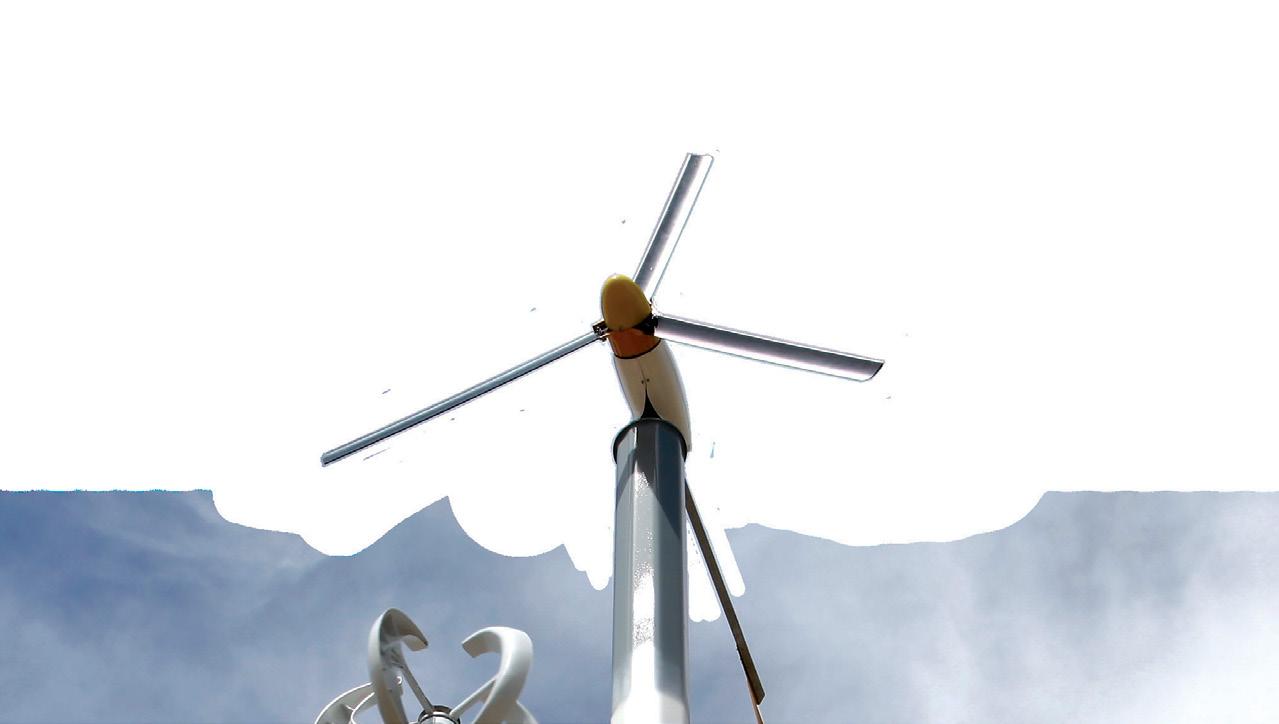
CEAT SENIORS' DESIGN PROJECT GOES UP IN STILLWATER
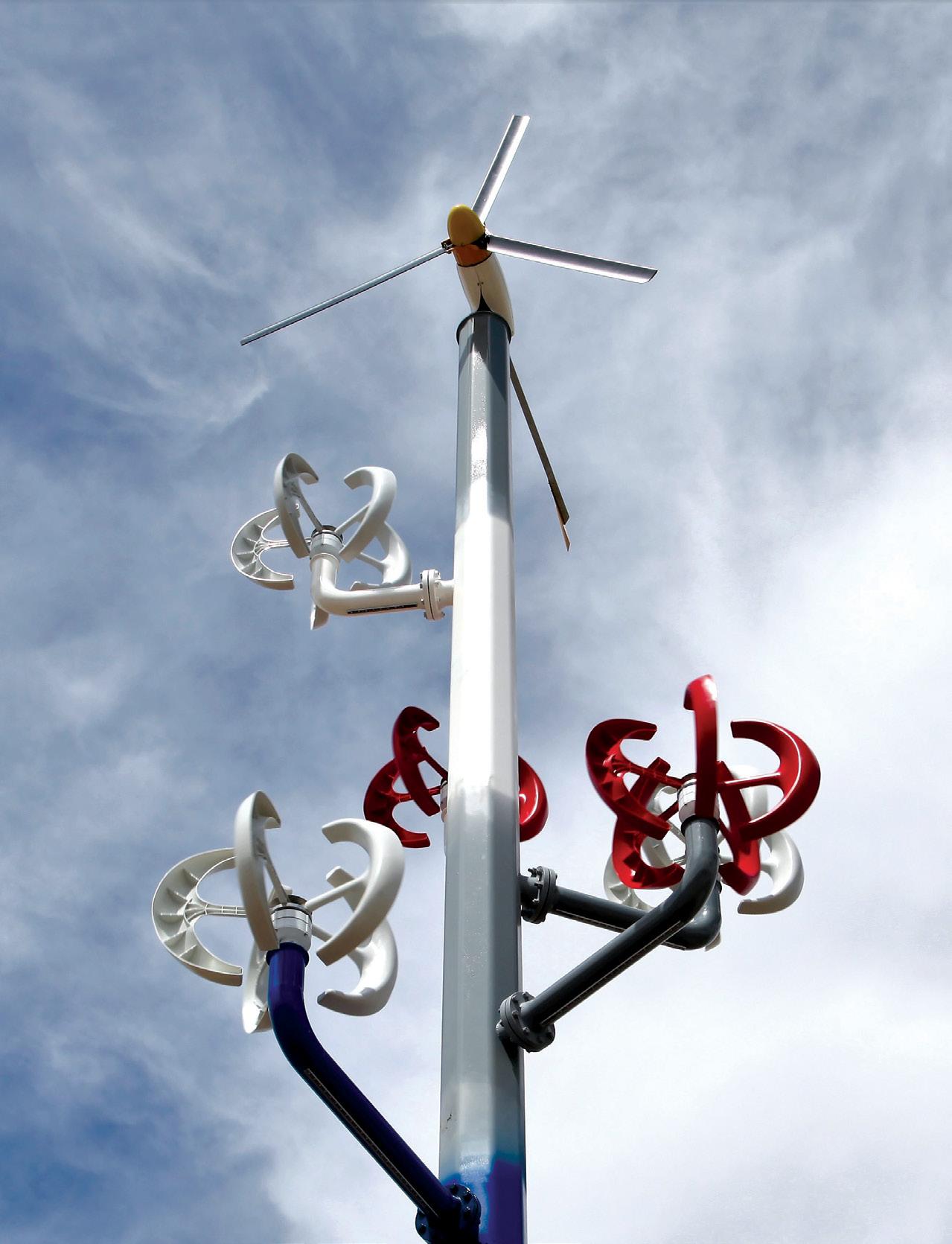
2019




On The Cover 20
Seven Oklahoma State University engineering students’ senior design project, a wind turbine, was installed in downtown Stillwater in April. Other projects were displayed at the Senior Design Expo, which brought together seniors from all the schools in the College of Engineering, Architecture and Technology, in ENDEAVOR. (Photo by Kristi Wheeler)
Alumni Update
32
Lee Easton has two bachelor’s degrees, four companies and a full-time engineering job — he knows what it means to work hard.
34
Ruth Spivey, OSU’s first female electrical engineering graduate, went through a lot to achieve her career success.
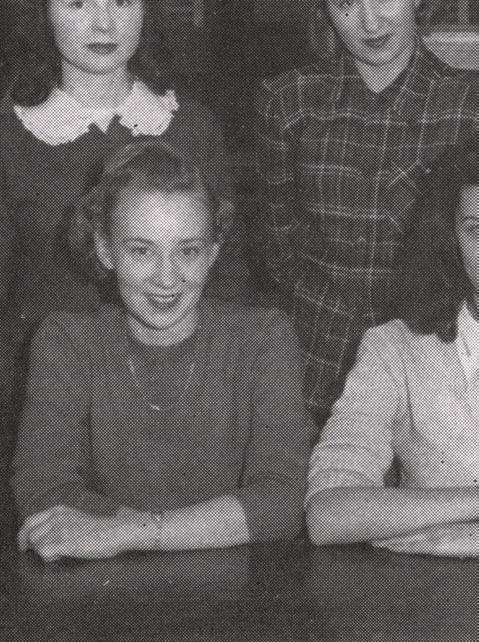
Research
36
Dr. Imraan Faruque is studying bees which could help autonomous drones better work as cohesive units.
38
Two OSU researchers have a new proposal for rebuilding America’s interstate infrastructure for the 21st century.
42 OSU’s College of Engineering, Architecture and Technology and College of Arts and Sciences are playing a role in research on dolphins.

3 Dean’s Letter
7 Seniors of Significance
15 College Heads
30 CEAT Bytes
56 Scholarships
58 Donors
64 Hall of Fame
DEAN, COLLEGE OF ENGINEERING, ARCHITECTURE AND TECHNOLOGY
Paul Tikalsky, Ph.D., P.E., F.ASCE, F.ACI, EACR
MARKETING MANAGER
Kristi Wheeler
LEAD WRITER
Jeff Hopper
UNIVERSITY EDITOR
Dorothy L. Pugh
ART DIRECTOR
Paul V. Fleming
PHOTOGRAPHY
Phil Shockley, Gary Lawson, CEAT Staff
IMPACT is a publication of the Oklahoma State University College of Engineering, Architecture and Technology and is designed to provide information on college activities and accomplishments while fostering communication among the CEAT family and friends. WWW.CEAT.OKSTATE.EDU
The office of publication for IMPACT is 307 Whitehurst, Stillwater, OK 74078-1024. © 2019, IMPACT. All rights reserved.

Oklahoma State University, in compliance with Title VI and VII of the Civil Rights Act of 1964, Executive Order 11246 as amended, and Title IX of the Education Amendments of 1972 (Higher Education Act), the Americans with Disabilities Act of 1990, and other federal and state laws and regulations, does not discriminate on the basis of race, color, national origin, genetic information, sex, age, sexual orientation, gender identity, religion, disability, or status as a veteran, in any of its policies, practices or procedures. This provision includes, but is not limited to admissions, employment, financial aid, and educational services. The Director of Equal Opportunity, 408 Whitehurst, OSU, Stillwater, OK 74078-1035; Phone 405-744-5371; email: eeo@okstate. edu has been designated to handle inquiries regarding non-discrimination policies. Any person (student, faculty, or staff) who believes that discriminatory practices have been engaged in based on gender may discuss his or her concerns and file informal or formal complaints of possible violations of Title IX with OSU’s Title IX Coordinator 405-744-9154.
This publication, issued by Oklahoma State University as authorized by the College of Engineering, Architecture and Technology, was printed by Royle Printing, at a cost of $6,388/4M/Aug 2019/job #8807.

38 54 74
…
Plus
32 34 38
42
IN THIS ISSUE OSU COLLEGE OF ENGINEERING, ARCHITECTURE AND TECHNOLOGY 1


ONLINE Reaching Students Around the World! 100% Online Graduate Programs in: Also Offering Undergraduate and Graduate Online Courses in: Advance your education today! 405-744-5146 ceatonline.okstate.edu • Engineering and Technology Management (M.S.) • Electrical and Computer Engineering (M.S.) • Fire Safety and Explosion Protection (M.S.) • Industrial Engineering and Management (M.S.) • Fire and Emergency Management (M.S. & Ph.D.) • Architecture • Construction Management Technology • Electrical and Computer Engineering • Electrical Engineering Technology • Engineering Sciences • Fire and Emergency Management • Fire Protection and Safety Technology • General Engineering • Industrial Engineering and Management • Material Sciences and Engineering • Mechanical Engineering Technology ENGINEERING EDUCATION Flexible Setting · Accessible · Quality Instruction · Affordable ONLINE LEARNING College of Engineering, Architecture and Technology
From the Dean


Dear Friends and Alumni, The College of Engineering, Architecture and Technology is accelerating with levels of change and transformation not seen since its founding more than 120 years ago. Interdisciplinary and hands-on learning with advanced analytic tools and laboratories is leading to more complex projects, entrepreneurial experiences and student competition victories.
The Grand Challenges Scholars program launched in 2015 with leading engineering programs around the world. This year, OSU’s Grand Challenges Scholars team was selected to compete at the Grand Challenges summit in London, joining four other major universities as the American team. OSU students also came out on top of the USAF Aerospace Propulsion challenge, the regional concrete canoe competition and a flurry of other competitions this year.
We awarded more than 1,050 degrees this year, a 40 percent growth in engineering bachelor’s degrees in five years, despite a net loss in annual state support of more than $4,500 per graduate. We have worked with students, administration and alumni to continue to deliver world-class engineers and design professionals. By expanding our facilities, accelerating our online options and offering degree minors, undergraduate research opportunities and honors degrees, we are pushing forward in creating leaders for the next generation of industry.
The ENDEAVOR lab and initiative opened in September 2018 to transform the undergraduate experience with large-scale, hands-on labs with entrepreneurial manufacturing space for student ideas and dreams. There is no change agent like it in the world. Faculty members are redesigning curriculum to better use the integrated capabilities, and students are being trained to prototype their own ideas to build their own future. I invite you to come to campus to see that future.
Our CEAT students traveled to northern Thailand, Cambodia and Vietnam to see the contextual solutions of technical problems around the world. Others traveled to Japan, Korea, Spain, China and Mexico to gain international experience before graduation.
We are experiencing more students graduating in four years, coming in better prepared for the rigors of CEAT degrees, retaining beyond the first year at the highest levels in decades, and engaging in undergraduate research and community service every day. It is exciting to be at OSU and in the College of Engineering, Architecture and Technology.
We continue to need alumni and friends to invest in the next generation. Consider a $1,000 donation to the CEAT Scholarship fund, that would be matched by the OSU Foundation for Engineering, to give OSU students the best chance to change the world. You might also consider joining the CEAT Dean’s Club, which recognizes distinguished supporters who have given $5,000 annually to the CEAT Fund or Scholars Fund or more than $250,000 in their lifetime. Dean’s Club members have a $2,500 scholarship in their name funded by the OSU Foundation for Engineering and meet with the dean about new ideas, legislative initiatives and help with the strategic direction of the college.
On behalf of OSU and CEAT, I hope you enjoy the IMPACT of OSU. The college could not be at the forefront of innovation without the accomplishments and investments of alumni, friends and industry partners like you.

GO POKES!
Paul Tikalsky Dean College of Engineering, Architecture and Technology

OSU COLLEGE OF ENGINEERING, ARCHITECTURE AND TECHNOLOGY 3
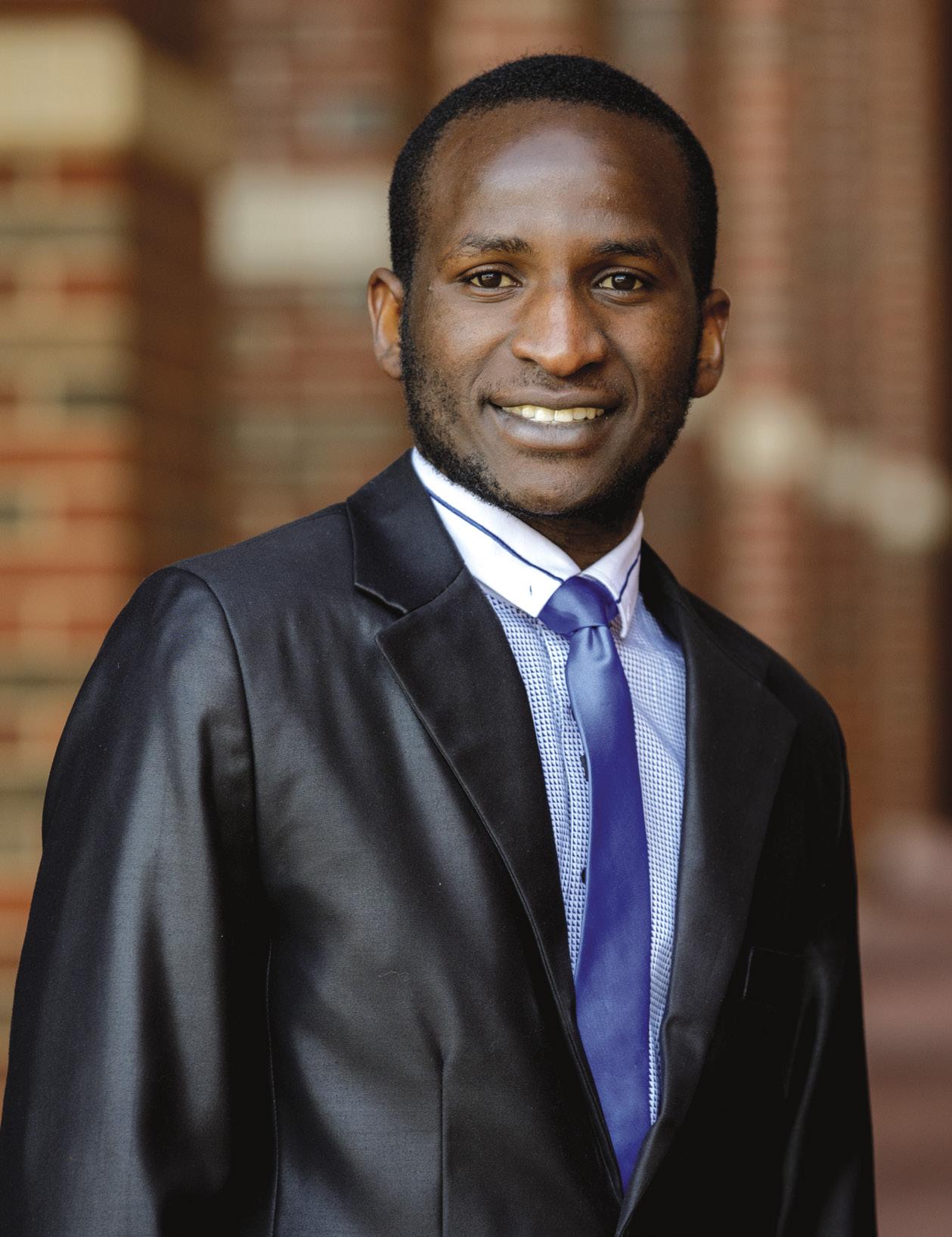
“I have one principle: If the worst thing I can get is a ‘no,’ that can’t kill me, and that has pushed me to try everything.”
4 IMPACT 2019
— MUWANIKA JDIOBE
It Takes a Village
Uganda’s Jdiobe credits CEAT support for his success at OSU
Muwanika Jdiobe’s first trip out of his native Uganda came in his pursuit of his degrees in mechanical and aerospace engineering at Oklahoma State University.
It would be a long trip, but his life had already been full of arduous challenges.
At 13, Jdiobe found himself taking care of his three younger siblings after their parents died. As the eldest, he became responsible for finding food and paying for school and health care for his family. He would sometimes go hungry to ensure his siblings’ well-being, he said. But nothing stopped him from staying optimistic.
Or becoming educated. Throughout his high school years, he participated in his school’s science fairs. Being from an area with few supplies, he did not have many tools or resources for his projects — but he still managed to create an alternating generator to make hydroelectric power.
Jdiobe said he always had a curiosity about airplanes, and his teachers pushed him to learn more. He discovered online that mechanical and aerospace engineers are responsible for making airplanes.
After doing more research, Jdiobe found that Africa did not offer this type of educational program. He looked at universities around the U.S. and thought OSU offered the best engineering program with a low cost of tuition.
“Everyone thought I was crazy that I wanted to leave my village and study in America,” Jdiobe said. “I had never even seen an airplane in real life, and that acted as my motivation to come to Stillwater.”
Early Hurdle
Originally, he was sponsored by a community member in Uganda who paid for him to attend OSU. But within his first semester of school, his sponsor unexpectedly died, leaving Jdiobe no way to cover his school, housing or food costs. He was lost and did not know where to go or who to turn to for help.
“I have been the instrumental communication for [Jdiobe] and was fortunate to be at the right place at the right time to help him,” said Regina Henry, coordinator of immigration for OSU
International Students and Scholars. “Community members of Stillwater and donors to OSU were generous enough to donate money to him to ensure that he was able to get tuition and finish his schooling.”
Throughout the 43 years that Henry has been in her position, she has seen multiple students forced to return home due to insufficient funds. She said she believes it has been a miracle for Jdiobe to stay at OSU.
“All of the community is rooting for [Jdiobe] and
ACADEMIC HONORS
In his senior year alone, Muwanika Jdiobe racked up several academic honors:
■ One of 15 Outstanding Seniors at OSU. The OSU Alumni Association recognizes seniors who excel through academic achievement; campus and community activities; athletic or extracurricular honors or awards; scholarships and work ethic.
■ O ne of 43 Seniors of Significance
■ A member of the top 1 percent of OSU’s class of 2019, which includes all six undergraduate colleges
■ An Outstanding Senior of CEAT.
his family in Uganda,” Henry said. “Members of his church, friends and professors have all been doing whatever they can to help him pursue an education, so he can enjoy his time in the United States.”
Wanting to get as much out of OSU as he could, he became a senator for residential life his first semester. He remained a senator with the OSU Student Government Association all four of his years at OSU. In the 2016-2017 school year, he was selected as the outstanding senator. In the
OSU COLLEGE OF ENGINEERING, ARCHITECTURE AND TECHNOLOGY 5
STORY MARK SCALMANINI | PHOTOS GARY LAWSON AND COURTESY OF MUWANIKA JDIOBE
2017-2018, Jdiobe became the central region ambassador for the National Association of Engineering Student Councils, which encompasses Oklahoma, Kansas, Texas, Arkansas and Missouri. He served as the secretary general of the African Student Organization at OSU. He also served as a CEAT Student Council member for four years.
Jdiobe worked in Parker Hall’s Living Learning Program as a mentor to CEAT freshmen. By becoming engrossed in the campus community and having constant interaction with CEAT students, faculty and staff, Jdiobe strengthened his relationships and networking at OSU.
Academic Opportunities
Jdiobe’s academic and leadership excellence have won him numerous scholarships. He has been chosen as a Grand Challenges Scholar from 2017 to 2019 and a Wentz Research Scholar during the 2018-2019 school year.
“I have been able to watch [Jdiobe] focus on his research and apply it personally to his community,” said Amanda Williams, Grand Challenges Scholars Program director. “It is fulfilling to watch him utilize what he has learned in the classroom and put it to use by benefiting his home country of Uganda.”
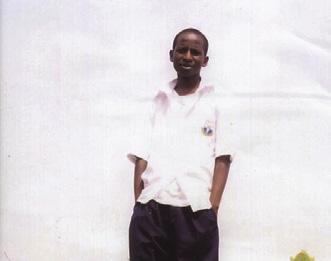
In the Grand Challenges Scholars Program, Jdiobe has taken advantage of every resource and opportunity available, Williams said, succeeding beyond the program’s expectations, putting others’ needs before his own, she added.
In addition, Jdiobe does research for two professors.
The past four years, he has been working for Dr. Tyler Ley, structural engineering professor, processing samples of concrete for about 20 hours of research a week.
“Dr. Ley has always offered me work in the research lab,” Jdiobe said. “I was given an amazing opportunity, being led to him and have done my best to exceed his expectations in research.”
He also does research for Dr. Jamey Jacob, mechanical and aerospace engineering professor, academic adviser and Grand Challenges Scholar adviser. There, he has established a platform of scientific studies about unmanned aerial vehicles. The platform is used to collect scientific information for studies and retrieve data from a UAV in the air to water below and vice versa for about five hours a week conducting research for Jacob.
Jdiobe is receiving some funds from research. He keeps a small portion for himself and sends money to his siblings in Uganda for food, education and health care. Since 2015, he has not seen any of his family.

“[Jdiobe] has a growth mindset and if something doesn’t work, he learns from it and goes about it another way,” Williams said. “I have enjoyed seeing what life is like through his eyes.”
OSU staff and faculty have noticed Jdiobe’s work ethic and drive. He is constantly thinking of how he can make a difference and make a change to improve everyone’s quality of life, Henry said. He is living proof that anyone can do anything, she added.
“I believe that I am one of the people who has been able to max out what CEAT has to offer,” Jdiobe said. “I have done research, taken advantage of scholarship and leadership opportunities. Every single thing CEAT has to offer, I have tried to get it. I have one principle: If the worst thing I can get is a ‘no,’ that can’t kill me, and that has pushed me to try everything. I think that CEAT, and OSU at large, have offered me all aspects to benefit from.”
Jdiobe said he has no regrets about coming to OSU, adding that he is grateful to the many people here who contributed to his successes.
“In Africa, we have a saying that it takes a village to raise a child,” Jdiobe said. “And OSU CEAT has been my village to raise me up.”
Next up for Jdiobe: entering graduate school for a master’s degree in mechanical and aerospace engineering.
“Despite not seeing my friends and siblings in years, I want to continue to further my education, because it is my dream,” Jdiobe said. “As someone from an impoverished country, I can acknowledge the gap between developed and underdeveloped countries. I would love to take the challenge and opportunity to take my unique experience and build UAV systems in developing countries to boost their safety against terrorism. I want to develop low-cost drones that would give people intelligence to reduce terrorism ambushes. Regardless of where I will be, that is one thing I want to accomplish and is the whole reason I want to get my master’s degree.”
6 IMPACT 2019
Muwanika Jdiobe home in Uganda in 2009 (left), and in 2011 (right).
Top Honors
CEAT seniors recognized with awards
Fourteen CEAT seniors were named Oklahoma State University Seniors of Significance by the OSU Alumni Association. The award recognizes students who have excelled in scholarship, leadership and service to campus and the community, and have brought distinction to OSU.
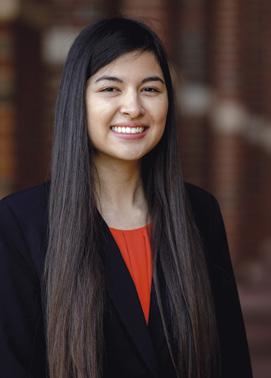




Seven of them — Madeline Hawkins, Muwanika Jdiobe, Rebecca Lane, Jasmyn Lee, Rachael Indah Merkel, Joanna Quiah and Colton Tubbs — were also named 2019 Outstanding Seniors by the OSU Alumni Association. The award recognizes seniors who excel through academic achievement; campus and community activities; academic, athletic or extracurricular honors or awards; scholarships and work ethic during their time at OSU.

Rebecca Lane
Chemical Engineering Beulah, Colorado
Jasmyn Lee
Civil and Environmental Engineering

Lawton, Oklahoma
Madeline Hawkins
Industrial Engineering and Management Carrollton, Texas
Muwanika Jdiobe
Mechanical and Aerospace Engineering Jinja, Uganda
Rachael Indah Merkel
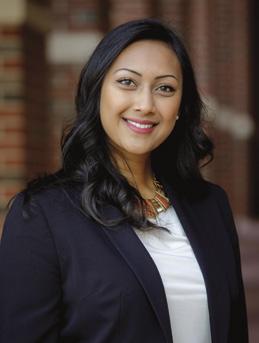
Mechanical Engineering Stillwater
Joanna Quiah
Biosystems Engineering
Edmond, Oklahoma
Colton Tubbs
Mechanical Engineering Hartshorne, Oklahoma
OSU COLLEGE OF ENGINEERING, ARCHITECTURE AND TECHNOLOGY 7
CEAT Dean Paul Tikalsky, left, and OSU President Burns Hargis, right, with the CEAT Seniors of Significance. Front row, from left: Cardin Hart, Luke MacNaughton, Muwanika Jdiobe and Rachael Indah Merkel; middle row: Sarah Desharnais, Madeline Hawkins, Jasmyn Lee, Joanna Quiah and Rebecca Lane; back row: Colton Tubbs, Patrick Steichen, Conner Blatt, Blake Giles, and Adam Morgan.
Chasing Dreams
W.W. Allen scholarship opportunity offers bright future to freshman from Bartlesville
As far back as he can remember, Fernando Gomez-Moran has enjoyed working with his hands, from building Lego set to toy cars.
The summer before his seventh-grade year in his hometown of Bartlesville, Oklahoma, his mother enrolled him in the Boys and Girls Club, where he stayed while his parents were at work. As the summer progressed, he experienced many opportunities through the organization to figure out what truly interested him.
“Our program is structured in such a way that we have the kids get involved in as many different things as we can,” said Jason Barta, chief executive officer of the Bartlesville Boys and Girls Club. “It is our goal with every child to help them discover their talents.”
Gomez-Moran reiterated that "the Boys and Girls Club taught me that being unique is what has the ability to change the world."
In middle school, he decided to take a technical education course.
“My middle school offered a technical education course, and in it we worked on different projects, like Rube Goldberg machines, which helped me express my imagination and turn my thoughts into physical matter. I think that is where my passion for engineering really stems,” Gomez-Moran said.
After Barta did a community presentation on the Boys and Girls Club, he wanted to get the word out about the W.W. Allen Boys and Girls Club Scholarship.
The scholarship, funded by W. Wayne Allen, retired CEO and chairman of Phillips Petroleum Co., benefits Boys and Girls Club members in high school who wish to pursue an engineering education.
Barta reached out to Karen Lowe-Alton, the executive director of the Lowe Family Young Scholars Program, which Gomez-Moran has been involved in since 2012. The Lowe Family program assists academically promising, economically disadvantaged students in the Bartlesville Public School System.
“Jason approached me to see if we had any Boys and Girls Club members, who were also Lowe Family Young Scholars, who were interested in engineering,” Lowe-Alton said. “I mentioned Fernando, and I mentioned to Fernando that he should inquire about this scholarship.”
Barta asked Gomez-Moran if he would be willing to help with Oklahoma State University’s College of Engineering, Architecture and Technology STEM summer camp.
STORY DAKOTA KEITH | PHOTOS COURTESY OF FERNANDO GOMEZ-MORAN
“My personal goals while at OSU are to gain knowledge and to learn how to use that knowledge for myself and the community and people who supported me through some of the roughest times of my life.”
8 IMPACT 2019
— FERNANDO GOMEZ-MORAN

OSU COLLEGE OF ENGINEERING, ARCHITECTURE AND TECHNOLOGY 9
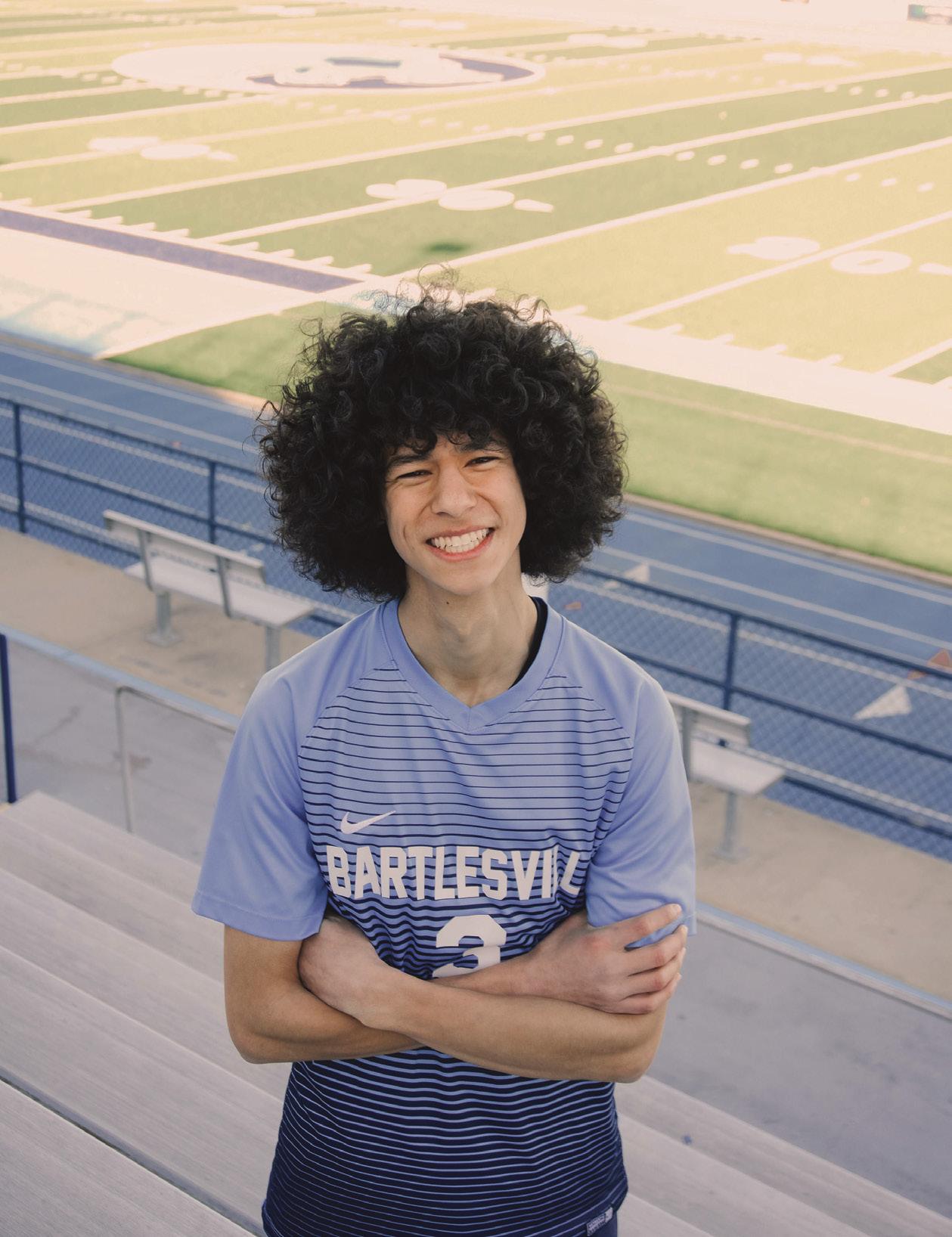
10 IMPACT 2019
“I met with Fernando and his parents not only about the scholarship, but his availability to help out with our summer program,” Barta said. “We encourage our teen club members to apply for jobs at the Boys and Girls Club working with our younger members. Fernando is such a wonderful role model to other kids; we felt it would be a wonderful opportunity for him to have a positive impact on others.”
The CEAT summer camp, Engineering Adventure, uses the Bartlesville Boys and Girls Club as a host site.
As an Engineering Adventure camp staff member, Gomez-Moran assisted in conducting the camp, where students in kindergarten through fifth grade learn engineering design principles with interactive and fun projects based on hands-on STEM activities.
Gomez-Moran was already seriously considering attending OSU when Amanda Williams, CEAT Scholar development manager, contacted him about everything the university could offer him, from scholarships to the educational opportunities in CEAT.
“Before I worked at the summer camp, I attended CEAT Discovery Days at the beginning of the summer between my junior and senior year of high school, and I got to see the classrooms,” Gomez-Moran said. CEAT Discovery Days gives high school students the opportunity to explore various engineering disciplines through activities and presentations.
“Then, I attended the Society of Hispanic Professional Engineers (SHPE) Discovery Days, and I got to see the ENDEAVOR lab,” he added. “It is outstanding that a college will invest in its undergraduate students and build a multimilliondollar building to help them with their research.”
The offer of an incredible opportunity — the W.W. Allen Boys and Girls Club Scholars Program — really sealed the deal on the university GomezMoran ultimately chose.
This OSU scholarship program awards incoming freshmen $15,000 per year for up to four years of study toward a bachelor’s degree in engineering.
“Scholars participate in enrichment activities and travel together,” Williams said. “In addition to the $15,000, he will receive $2,000 to participate in enrichment activities and $3,000 for international travel.”
Gomez-Moran was also selected as a CEAT Scholar. To qualify, students must have applied to OSU, have a minimum 31 ACT score and 3.75 GPA and interview with a faculty member and a current scholar to assess their character, leadership abilities and affinity for engineering.
“I have been given an incredible opportunity,” Gomez-Moran said, adding he plans to make good use of his time at OSU.
“My personal goals while at OSU are to gain knowledge and to learn how to use that knowledge for myself and the community and people who supported me through some of the roughest times of my life,” Gomez-Moran said.
“I plan on graduating college and entering graduate school prepared to use everything I previously learned to research and develop technology that will better the world and humankind in its quest for greater efficiency and productivity.”
After graduation, Gomez-Moran would like to start his career with an aviation company such as Boeing, Lockheed Martin or Northrop Grumman before moving on to an automaker such as Subaru, Porsche, Ferrari or Lamborghini.
Gomez-Moran said he hopes his future career will allow him to support charities that ensure that the next generation of students are prepared to be educated.
“I have the best opportunity and empowerment at OSU to achieve my dreams,” Gomez-Moran said.
OSU COLLEGE OF ENGINEERING, ARCHITECTURE AND TECHNOLOGY 11
Broader Experiences
Study abroad trips open eyes and minds for OSU faculty and students
In 2007, Keith Teague took his first trip to Asia, visiting industries and political groups in Vietnam to discuss economic development and education. Today, Teague, a professor in the school of electrical and computer engineering at OSU, leads study abroad trips each year to Japan.
“People in different parts of the world deal with being engineers in different ways,” Teague said. “So there are differences in the way they practice and in the way products are designed and manufactured. There are differences in cultural aspects of this, too. In Japan, so much focus is on the community as opposed to the individual, whereas here is much different. Needs are much different. If you go to another country, they have different social, political and cultural needs than we do here.
“I think it’s very important for students to see there’s more to the world than just us.”
Nick Overacker took advantage of the opportunity to study abroad during his college career. Overacker graduated in the fall of 2018 with
a degree in electrical and computer engineering from OSU. He cited his curiosity for bringing him to ECE and leading him to a minor in Japanese.
“With electronics, I felt there was this huge part of the world around me that I didn’t understand, and I wanted to learn what the secrets were to that,” he said. “When I started studying Japanese, I actually didn’t know anything about the culture. During my second year of studying the language, I became involved in the Japanese Student Association. Through that, I made a lot of Japanese friends and got very close to a lot of them. OSU has usually fewer than 20 Japanese students on campus at one time. So I was able to get to know all of them. It made me very interested in going to Japan.”
In 2016, Overacker did just that, spending 13 months as an exchange student in Japan.
“The way people interact with each other and with their environment, and generally every aspect of their life in Japan is just very different than in the United States,” he said. “It gave me a completely
The CEAT Japan study abroad students, Dr. Norb Delatte (left) and Dr. Keith Teague (far right) along with several Japanese students visited the Kiyomizudera Temple, meaning "Pure Water Temple," in Kyoto, Japan.

STORY CEAT MARKETING | PHOTOS COURTESY OF KEITH TEAGUE
12 IMPACT 2019
new outlook and showed me a different way to live life. I gained marketable language skills and insights on ways to live life. I don’t have to just follow what’s prescribed for me here. I can choose the best of everything I know. And I feel like I gained some insight on different markets, the way people interact with products and technology in other countries.”
Overacker “definitely” recommends studying abroad.
“It’s going to be easier as a student than afterward. You don’t have a summer break or a year to take off for something like that, after graduating,” he said. “There’s a lot of funding available, which a lot of people don’t realize. People often say ‘I want to study abroad but I can’t afford it.’ I was someone who couldn’t afford to go to school in the first place. I came to school on the funding available,
and I went abroad on much more funding that was available. Before I went, I applied for several study abroad scholarships, some at OSU and some outside. I recommend everyone apply to as many scholarships as they can. I ended up going with $30,000 in funding.”
Since graduating, Overacker accepted a position at Wavetech LLC in Stillwater, which was founded in 2011 by Dr. John O’Hara, an assistant professor in ECE. The company participates in cutting-edge research and provides practical, customer-oriented services in engineering. O’Hara recruited Overacker at a robotics event on campus.
Samer Elkhalid, a May 2018 graduate in electrical and computer engineering, also did a study abroad trip. Growing up, he was fascinated with digital devices, especially computers, and enjoyed anime and video games. Those gave him a
Himeji Castle in Himeji, Japan is considered the best remaining example of Japanese castle architecture. CEAT Japan study abroad students visited and explored the castle.
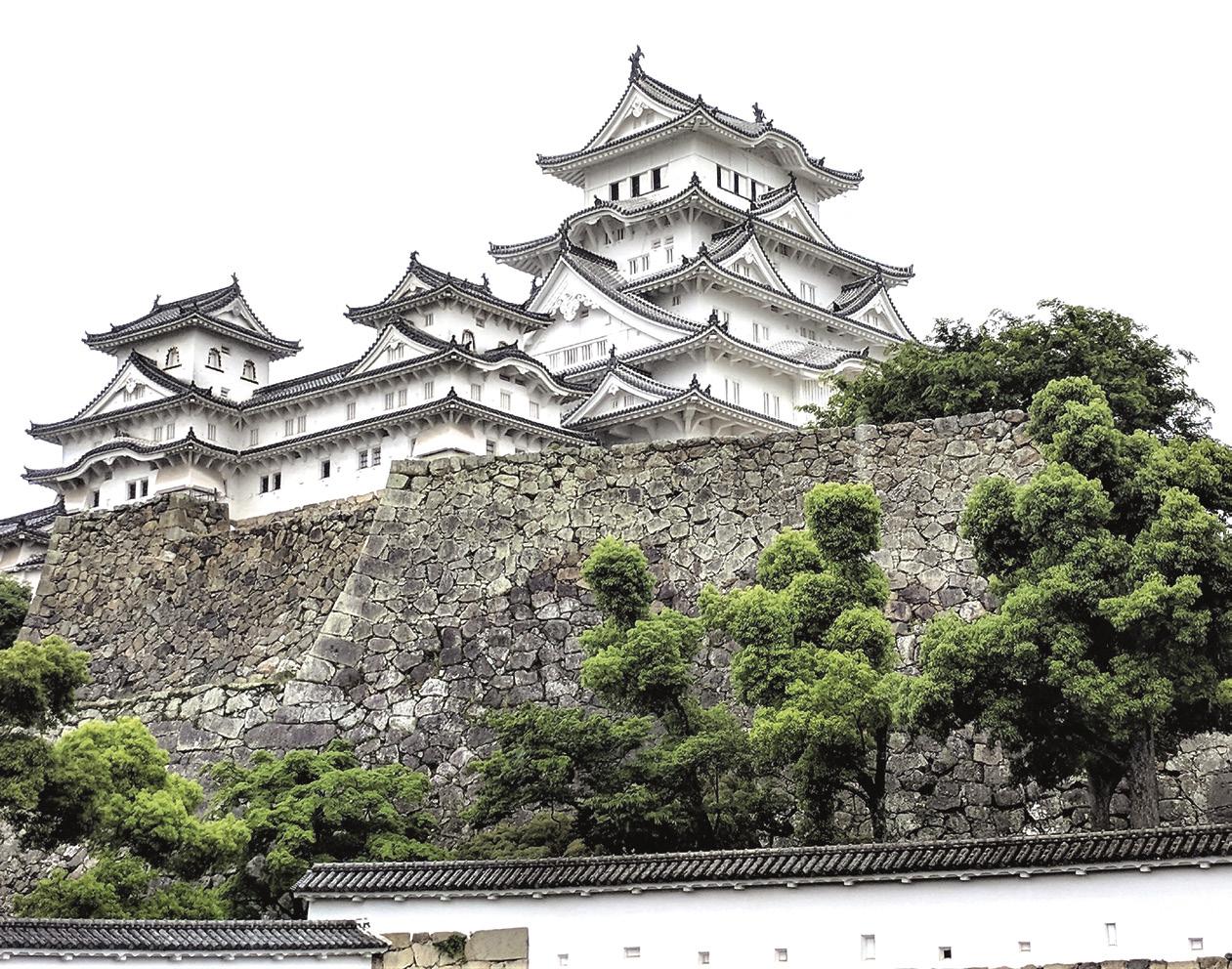
OSU COLLEGE OF ENGINEERING, ARCHITECTURE AND TECHNOLOGY 13
fascination with Japanese culture, and he fulfilled his dream of visiting Japan on a study abroad trip with Teague and Dr. Norb Delatte in May 2017.
“I loved every bit of it! We got to go sightseeing on many cultural tours seeing many castles, shrines and temples,” Elkhalid said. “We went on various business tours, including a trip to Sony World Headquarters in Tokyo, which was my personal favorite business trip. And we got to have some time to ourselves exploring the various cities we went to such as Tokyo, Osaka, Negoya and Hiroshima.”
The experience changed Elkhalid’s education in the United States.
"Going on this trip was like a dream come true! I definitely have a wider perspective of how a different culture can operate,” he said. “Learning about the importance of teamwork can go a long way. One big thing that I noticed about the Japanese while I was there is that they are very efficient and hard-working. It’s like they are a very homogeneous society, and every individual does what they can to be a productive member of the society. After my trip, I felt more willing to give help and be more of a volunteer to my senior design partners, and at the same time, be willing to receive help from them.”
Teague has spent many years building relationships with contacts in Asia to make the study abroad trips educational as well as fun. The itinerary includes tours of Mitsubishi Heavy Industries, Takenaka R&D Institute and Toyota, as well as cultural visits to Hiroshima, Miyajima Island and Kyoto.

“I think they’re tremendous experiences and I think there are a lot of students that don’t realize what they’re missing,” Teague said. “If we can help convince them that this is the sort of thing they ought to try at least once in their life, I think many of them would get something out of it they may not even know they’re missing.”
Since graduating from OSU, Elkhalid accepted a job as a software engineer at Epiroc Drilling Solutions.
“People in different parts of the world deal with being engineers in different ways. I think it’s very important for students to see there’s more to the world than just us.”
( )
— DR. KEITH TEAGUE
14 IMPACT 2019
Students visited the Meiji Shrine, an iconic Shinto shrine located in Tokyo.
COLLEGE HEADS
Norb Delatte, P.E., F.ACI, F.ASCE Professor and Head M.R. Lohmann

Endowed Chair; Civil and Environmental Engineering
Jeffrey L. Young , P.E., F.IEEE Professor and Head OSURF Endowed Chair; Engineering Electrical and Computer Engineering


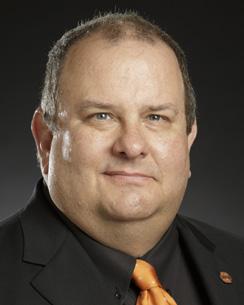
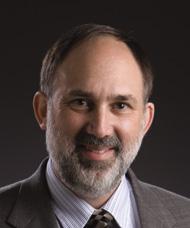


Suzanne Bilbeisi, AIA Professor and Head Centennial Professor of Architecture; School of Architecture

John Veenstra , P.E., BCEE Professor and Head Decker Dawson Chair; Biosystems and Agricultural Engineering

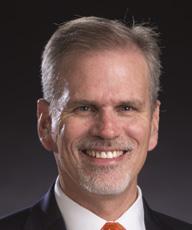
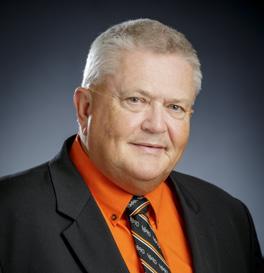
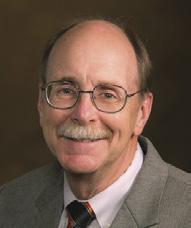
Geir Hareland Professor and Head; Continental Resources Chair; Chemical Engineering
Sunderesh Heragu
Regents Professor and Head; Donald and Cathey Humphreys Chair; Industrial Engineering and Management
Dan Fisher Professor and Head
Albert H. Nelson Jr. Chair; Mechanical and Aerospace Engineering
Young Chang , P.E., CFPS Professor and Head; Engineering Technology
 Paul J. Tikalsky CEAT Dean
Randy Seitsinger Associate Dean, Academic Affairs
Chuck Bunting Associate Dean of Research Ed Kirtley Assistant Dean of Engineering Extension
Raman Singh
Paul J. Tikalsky CEAT Dean
Randy Seitsinger Associate Dean, Academic Affairs
Chuck Bunting Associate Dean of Research Ed Kirtley Assistant Dean of Engineering Extension
Raman Singh
OSU COLLEGE OF ENGINEERING, ARCHITECTURE AND TECHNOLOGY 15
Associate Dean of Engineering, OSU-Tulsa; Director, Helmerich Research Center
Jostling for Jobs
CEAT Career Fair draws record number of employers
More companies than ever before turned out to recruit students at the CEAT Career Fair last September.
Oklahoma State University’s College of Engineering, Architecture and Technology Student Council members, alongside OSU Career Services staff, hosted the annual event for students seeking jobs and internships.
About 2,200 students — 2,000 of them CEAT students — connected with leaders in the science, technology, engineering and math industries. The CEAT Career Fair is the largest career fair at OSU and is often recognized nationally, according to OSU Career Services.
Wade Witcher, a chemical engineering sophomore, was co-coordinator of the career fair, which drew 244 companies.
“We looked at the 2015, 2016 and 2017 career fairs to see if the same companies would return,” Witcher said. “If any companies didn’t come back, we tried to the best of our ability to get them back for this year.”
The CEAT Student Council had increased the price for career fair spots. Witcher said he wanted to bring more profit for CEAT Student Council by selling out Gallagher-Iba, and that’s exactly what they were able to accomplish.
“CEAT Student Council keeps all the profit from the career fair and places it into our operating budget,” said Maddie Hawkins, CEAT Student Council president and an industrial engineering and management senior. “We offer co-sponsorships to clubs and organizations for their events throughout the year, so their memberships can have the best.”
As president, Hawkins said it is one of her goals to try to give back as much as she can to the students while she is serving on CEAT Student Council. CEAT Student Council gives over half of the profit made from the career fair back to CEAT clubs.
“We want to build camaraderie between the students and recruiters to ensure they have the best experience they can at the career fair,” Hawkins said. “We try to focus on the benefit to the students the most.”
Many students wanted to see specific companies at the career fair, which led Witcher to chase those the students wanted.
Co-chair Nathan Hodges and CEAT Career Services Coordinator Andrea Haken also worked on the fair.
“CEAT does a great job at providing all aspects of the industry to its students,” said Haken. “Students have more options, and it opens the door to more opportunities that they can take advantage of.”
Haken said she helped oversee the career fair coordinators to navigate and troubleshoot problems. She helped recruit companies, but her main role was to prepare the students to be ready in all situations at the career fair.
“I review résumés, develop interview skills and teach how to talk with recruiters,” Haken said.
“At the CEAT Career Fair, industry leaders are searching for CEAT students, knowing what they are capable of,” Hodges said.
STORY MARK SCALMANINI | PHOTOS GARY LAWSON
“We want … to ensure (students) have the best experience they can at the career fair.”
16 IMPACT 2019
— MADDIE HAWKINS ( )

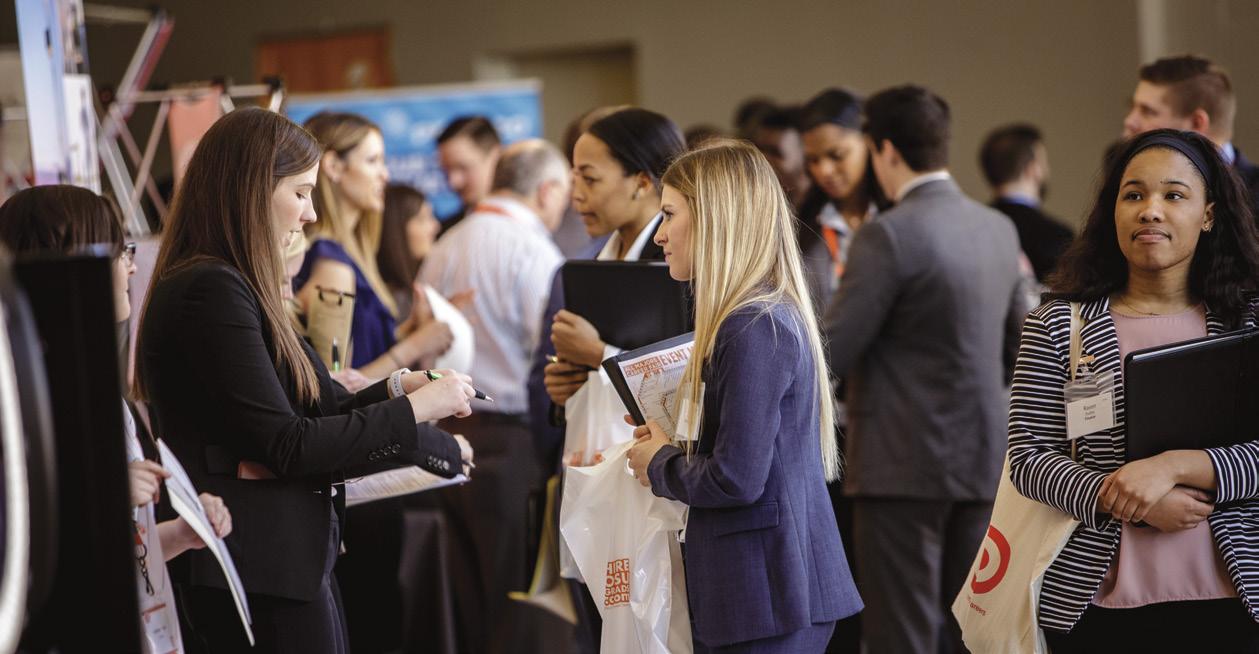
OSU COLLEGE OF ENGINEERING, ARCHITECTURE AND TECHNOLOGY 17
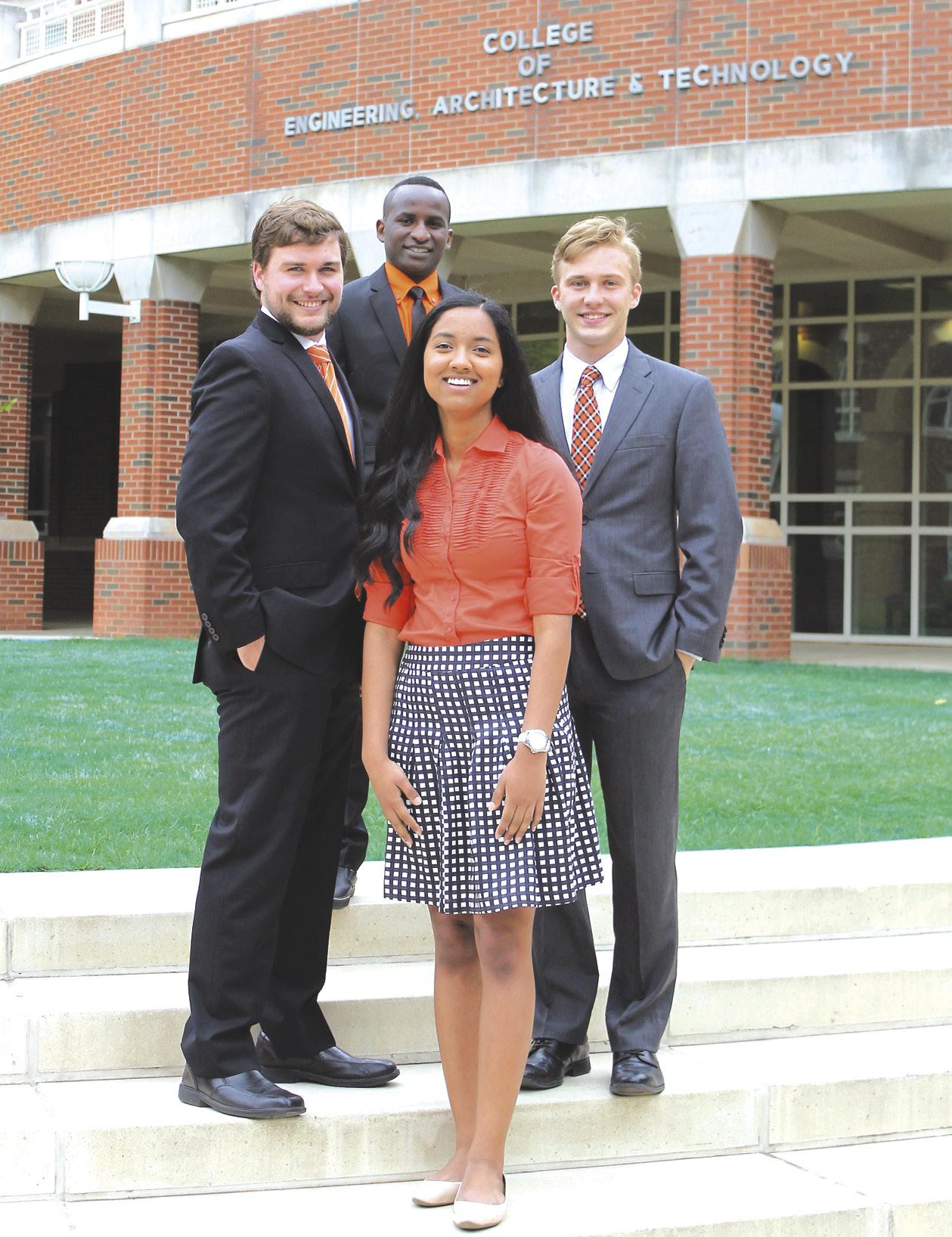 The members of OSU’s Grand Challenges team are (from left) Christian Griffith, Muwanika Jdiobe, Angela Peter and Jackson Moore.
The members of OSU’s Grand Challenges team are (from left) Christian Griffith, Muwanika Jdiobe, Angela Peter and Jackson Moore.
“… It is not just about the competition. This is about finding solutions to the challenges threatening the existence of humanity.”
18 IMPACT 2019
— MUWANIKA JDIOBE
Tackling a Grand Challenge
OSU team set to represent the U.S. in global competition
For the first time, a group of engineering students in Oklahoma State University’s College of Engineering, Architecture and Technology will represent the United States in a business plan competition at the 2019 Global Grand Challenges Summit in London.
The team is tackling the challenge of sustaining a global population of 10 billion, which the United Nations says will be reached by 2050. The OSU proposal calls for the advanced integration of technology into agriculture.
The team includes Christian Griffith, mechanical and aerospace engineering; Muwanika Jdiobe, mechanical and aerospace engineering; Jackson Moore, mechanical and aerospace engineering; and Angela Peter, chemical engineering.
Their idea is to utilize sensors underneath and on the surface of the ground, along with additional sensors on unmanned aerial vehicles to collect data from the air. This will allow them to analyze the soil and help farmers know where they need to fertilize and what crops would be best suited to that specific area, so that farmers could grow more crops at a lower cost. Crops can be too expensive to grow for many in underdeveloped countries.
OSU has one of the leading agricultural programs in the nation and conducts extensive research in this area. The team has access to that research and knowledge as well as opportunities for collaborating with some of the top minds in the field, empowering them to tackle the challenge effectively. Team members worked together, each handling different aspects of the project. Griffith focused on data analytics, Moore and Jdiobe focused on the sensors, while Peter focused on the customer discovery side of it, interviewing farmers from India and Uganda.
“Engineering problems are not just scientific problems; they are people problems,” Griffith said. “There were a lot more personable aspects than I expected out of what I thought was solely a research and business competition. It showed that we have the power to change lives.”
“We focused on how using unmanned aerial vehicles could be used to increase yield in the fields of Uganda.” Peter said. “This program is all about innovation, engineering and entrepreneurship. The work is very interdisciplinary in nature and involves making something new from what we have learned in our core courses. This project is greater in scope than our normal class work, and being able to use what I have learned and
applying it in the real world has been very rewarding. Learning and understanding the struggles of farmers in Uganda has helped us gain global awareness of struggles that exist outside of our personal spheres. I have grown in my collaborative and leadership skills, and developed my interpersonal communication skills. It has been very exciting to be the first team from OSU to make it this far.”
Moore saw this as an opportunity to unite two interests.
“I did research as a freshman research scholar and have a minor in entrepreneurship so the GCSP gives me the opportunity to combine the two interests,” Moore said. “I’ve grown in my public speaking experience, and I have been able to learn how to balance jobs and personalities with a group.”
Amanda Williams, coordinator of CEAT scholarships, felt this project had special meaning for Jdiobe.
“Muwanika is from Uganda,” Williams said. "He was telling us stories about when he was a child his family couldn’t afford to send food for lunches while attending school. It really does affect not just their health, but also their knowledge and learning abilities. Being able to solve this issue was very personal to him.”
Jdiobe said being a part of the competition is great, but, for him, it’s about so much more. “This is about finding solutions to the challenges threatening the existence of humanity, with the increasing world population and few resources, humanity is at stake, and therefore, it is upon all of us to make this world sustainable and better for all generations.”
PGA Tour star Rickie Fowler fully funds the Grand Challenges Scholarship Program in CEAT. While the golfer was not an engineering student, he has always loved tinkering and the technology side of things. He wanted to support students with a similar mindset.
CEAT Dean Paul Tikalsky presented the program to Fowler’s agent, noting “the students in a program like this would be like-minded because they’re very hands on with their research.” Fowler loved the idea that it was an extra component outside of the classroom and not just a scholarship — he is giving an experience, as well as money.
“The Grand Challenges were created in 2009, and OSU submitted a proposal to join in 2016,” Williams said. “As soon as a student applies to be a part of the program and is accepted, they are expected to continue until they graduate. Most students will have to start part of the program components before they apply. Having the program here at OSU helps us offer more opportunities for the students. They can focus a little more on what their passions are.”
OSU COLLEGE OF ENGINEERING, ARCHITECTURE AND TECHNOLOGY 19
STORY KRISTI WHEELER | PHOTO DAKOTA KEITH
WINDS OF CHANGE
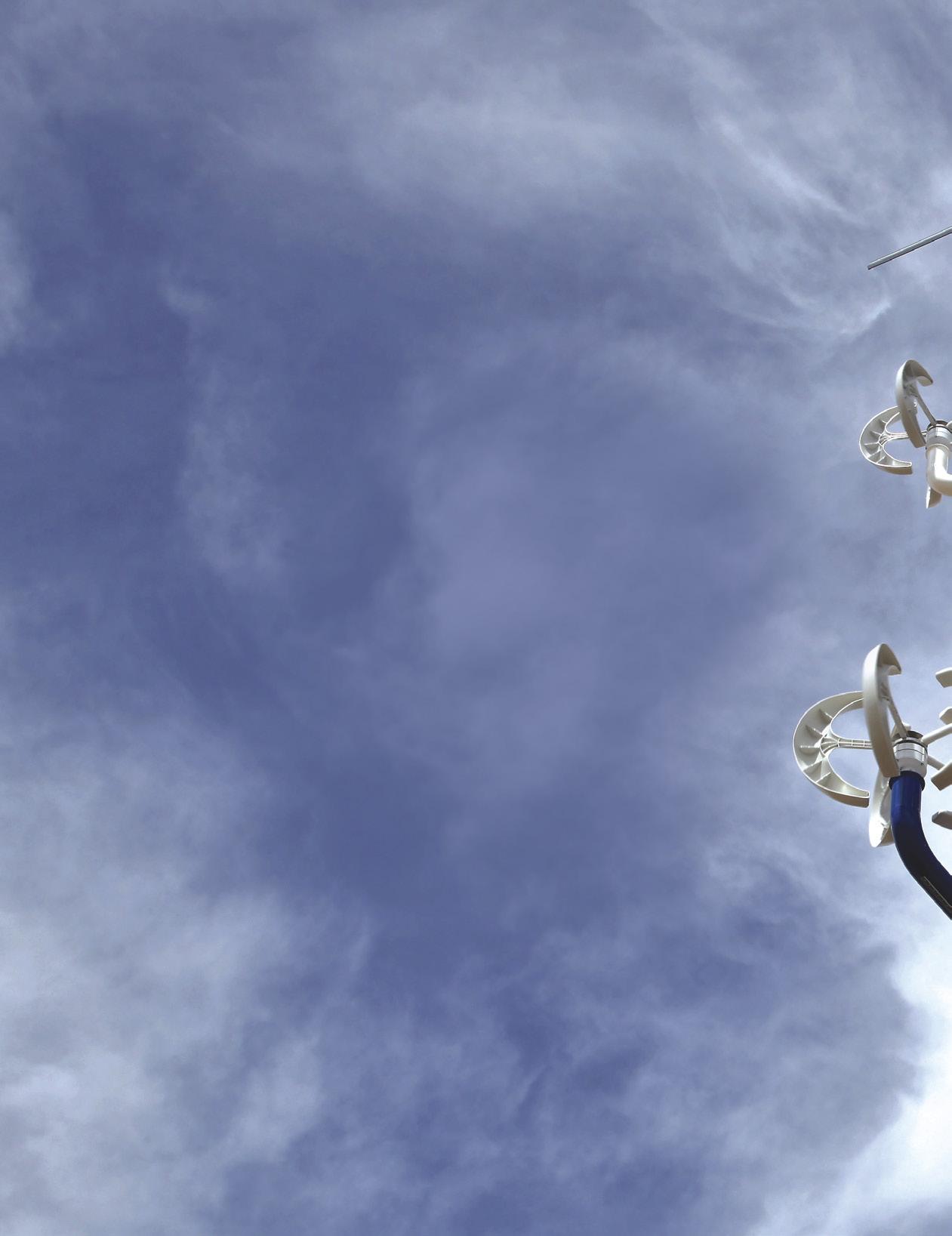
First Senior Design Expo including all CEAT schools propels ENDEAVOR toward a successful interdisciplinary future.
The key mission behind the College of Engineering, Architecture and Technology’s ENDEAVOR lab is to unite the various elements of the college in interdisciplinary projects.
The Senior Design Expo brought that mission to life in April.
“The Senior Design Expo was the vision of Dr. Jeffrey Young and Dr. Dan Fisher to showcase the work of our students,” CEAT Dean Paul Tikalsky said.
Previously, CEAT’s senior design showcases were hosted by individual academic units with little interaction between them, said Young, department head for the School of Electrical and Computer Engineering.
“Oftentimes, the showcases were not well advertised,” he said. “In short, the larger community outside of the unit did not know much about what our students were capable of doing. That insular operation also left interdisciplinary projects as a side thought,” Young said.
“ENDEAVOR gave us the opportunity to create the expo and to invest significantly in interdisciplinary senior design,” he said.
The trial run for a full interdisciplinary exhibition came in the form of the School of Mechanical and Aerospace Engineering and the School of Electrical and Computer Engineering joining forces to host a 19-project senior design expo in the center in fall 2018.
“We started modestly in the fall 2018 semester with just ECE and MAE participating,” Young said. “One semester later, we had buy-in from all CEAT units.”
The spring of 2019 brought together all six schools of engineering, the School of Architecture and the Division of
Engineering Technology to showcase their seniors’ capstone projects. More than 85 projects, many interdisciplinary in nature, were featured throughout expo day in ENDEAVOR, the 72,000-square-foot hallmark of CEAT.
Planning
Any large-scale event of this nature takes preparation, and many of the senior design projects were actually completely assembled in the facility.
“ENDEAVOR’s continuous challenge is to provide the resources and assistance for each department to follow the best path forward,” said Dr. Brad Rowland, the center’s manager of operations. “The ENDEAVOR team provides fantastic support. Our student employees really stepped up to support the design teams’ use of our makerspaces and laboratories that were supporting expo design efforts as early as February 2019.”
The ENDEAVOR Heat Exchanger Stand senior design team was an example of a project that was completely assembled in the building.
“It was fantastic being able to build our project in ENDEAVOR,” said team member Caleb Austin, a mechanical and aerospace engineering senior. “We didn’t have to outsource to a different area to build our project. All of the tools and the workspace were available to build our project from the ground up without having to use multiple areas.
“We got to utilize lab equipment that we didn’t formerly have access to. ENDEAVOR is a major upgrade from what undergrads had to work with and is a leading edge in senior design.”
STORY DAKOTA KEITH | PHOTOS PHIL SHOCKLEY AND KRISTI WHEELER
20 IMPACT 2019
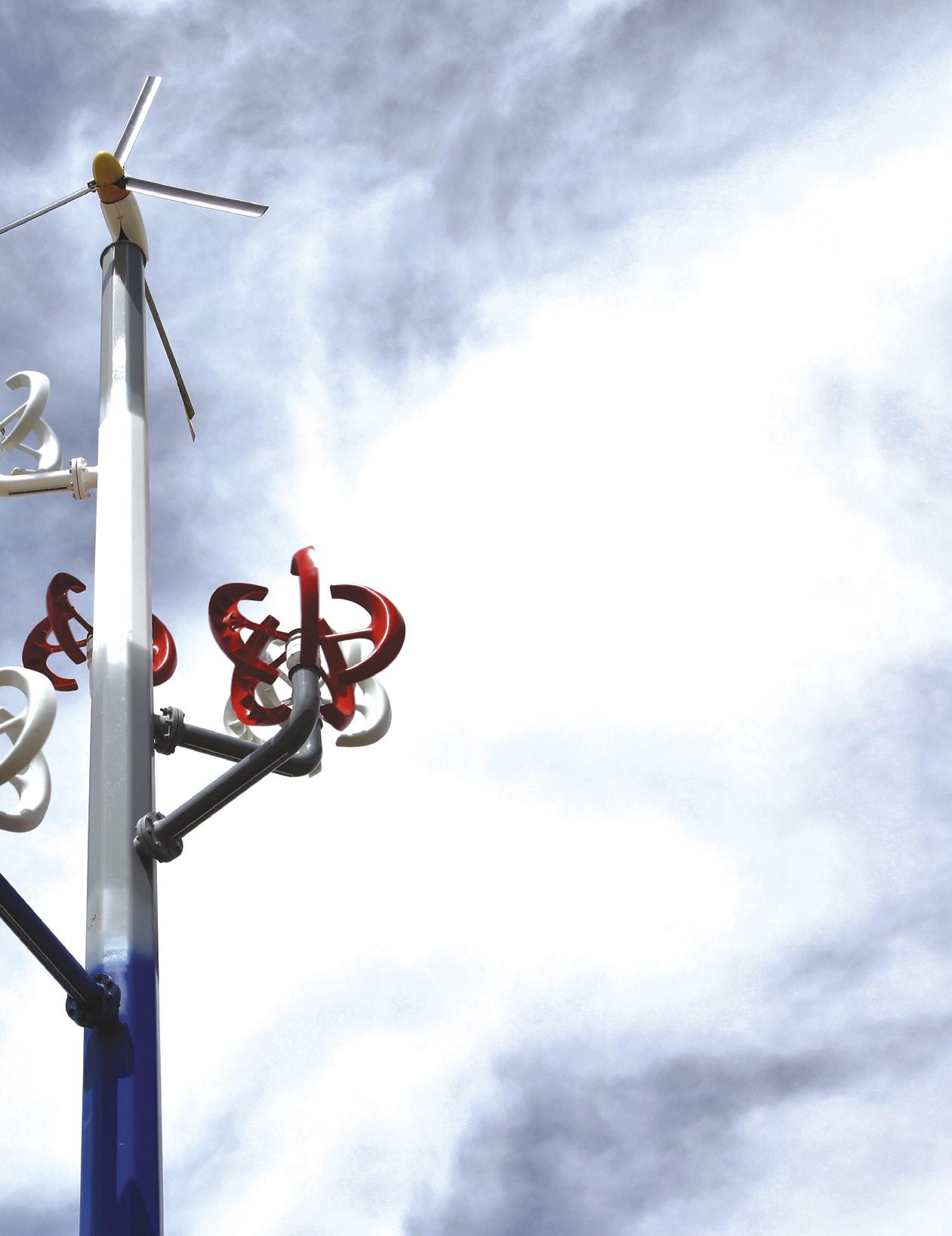
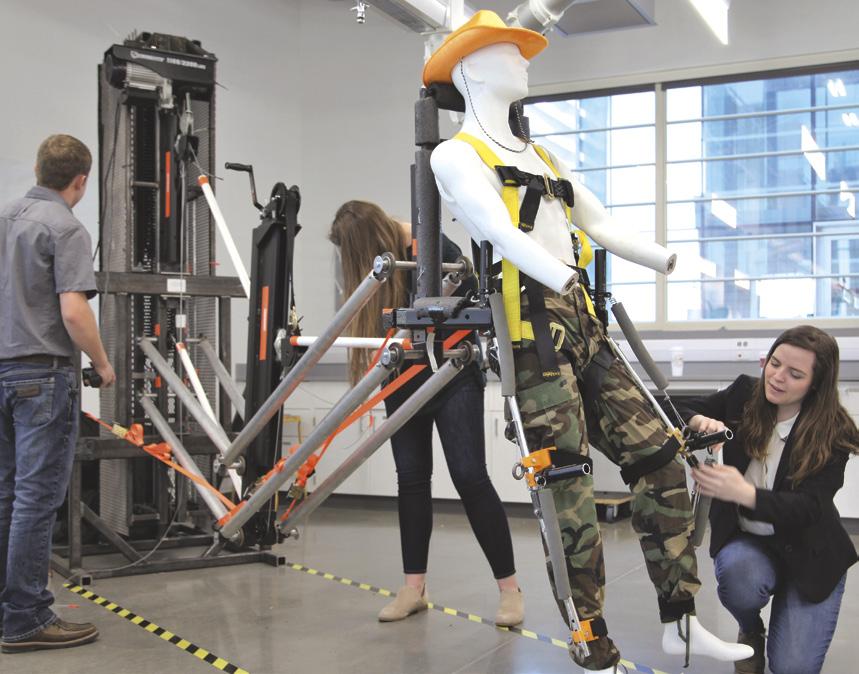
 Members of the hypogravity simulator project prepare a demonstration at the CEAT Senior Design Expo.
Students from the Wind Turbine/ Sculpture/Light Show interdisciplinary design team prepare to install their 40-foot tall wind-energy project in downtown Stillwater.
Members of the hypogravity simulator project prepare a demonstration at the CEAT Senior Design Expo.
Students from the Wind Turbine/ Sculpture/Light Show interdisciplinary design team prepare to install their 40-foot tall wind-energy project in downtown Stillwater.
OSU COLLEGE OF ENGINEERING, ARCHITECTURE AND TECHNOLOGY 21
The 40-foot wind turbine was installed in downtown Stillwater in April.
Still, some projects were built elsewhere on campus.
“The units of CEAT look at design support resources that are needed for each project,” Rowland said. “Based on the support required to complete the project determines where those projects will be built. Most instrumentation, additive manufacturing and assembly are done in ENDEAVOR.”
Counting Down
As students began the final assembly of their projects days ahead of the event, it would be the first time that some would see completed senior design projects from units outside their own.

“For the first time ever, as far as I know, individual unit silos are being torn down by bringing all CEAT units under one roof to celebrate CEAT-wide senior design activities,” Young said.
From Austin’s perspective the expo is like a grown-up science fair.
“The Senior Design Expo has created a platform where someone with no initial interest in our college can come see something cool and walk through the door to find out more.” Austin said. “It creates a platform where someone with no initial interest in our college can see something cool and walk through the door to find out more. It creates interest in what the college is providing for its students.”
The expo drew a varied audience, with family and friends as well as interested campus and community members attending.
The students enjoyed the benefits of a senior design expo that brought the units together, as well as offered opportunities for them to work with others from across the college.
“Being on an interdisciplinary team has been such a positive experience,” said Carson Dickerson, a member of the Wind Turbine, Sculpture and Light Show interdisciplinary senior design team and an electrical and computer engineering senior. “I got to see the strengths of mechanical engineering majors mixed with the strengths of
“(The Senior Design Expo) will become a CEAT signature event that shines a spotlight on who we are and what we do.”
( ) 22 IMPACT 2019
— DR. JEFFREY YOUNG
electrical engineering majors, and I got to see the benefits of those two groups working together.”
Real-World Taste
Working on interdisciplinary projects represents an elevation in education that is closer to the challenges that students will face after graduation, Tikalsky said.
“Working on an interdisciplinary project has given me such a realworld experience,” Dickerson agreed. “Throughout our project we experienced setbacks, dead dates and we worked with individuals outside of the school.”
Caleb Austin’s team did not include students outside the mechanical
and aerospace engineering program, but he still found the value in an interdisciplinary expo.
“Every project in every industry will be interdisciplinary,” he said. “You are not going to be working with just mechanical engineers. This expo allows us to share knowledge with other units.”
The expo will continue to be a work in progress, Young said, adding he expects it to expand and innovate on previous successes. However, the expo has already proven its value.
“It brings together graduates, prospective employers, prospective students, parents, members of the press, OSU leadership, Regents, public servants, alumni, advisory board
members and friends under one roof to see what our amazing students are able to do. It will become a CEAT signature event that shines a spotlight on who we are and what we do,” Young said.
Dean Tikalsky reflected on whether ENDEAVOR was accomplishing its mission of becoming an interdisciplinary design space for undergraduate students.
“ENDEAVOR has taken its first steps toward its goal.”

OSU COLLEGE OF ENGINEERING, ARCHITECTURE AND TECHNOLOGY 23

STORY
24 IMPACT 2019
KRISTI WHEELER | PHOTOS PHIL SHOCKLEY AND COURTESY OF DIANA RODRIGUEZ
STRONG
A MIND
Injured at OSU’s Homecoming parade, Diana Rodriguez takes her mother’s advice to heart

"Not only will I graduate, but I will walk — hopefully in heels — across the stage,” Diana Rodriguez said.
That might not sound like an extraordinary goal, but for Rodriguez, who suffered a broken spine, broken left leg and ankle, internal bleeding and head trauma in the 2015 Homecoming crash at Oklahoma State University, it’s just that — extraordinary.
Rodriguez, a native of Colombia, was a graduate teaching assistant on a Fulbright Scholarship, working on her doctorate in industrial engineering and management at OSU’s College of Engineering, Architecture and Technology. She was focusing her research on the application of quantitative models in humanitarian logistics, targeting recovery activities to better help affected people get to a “new” normal life. While she was working on her doctorate, her husband Cristian was also working on earning a master’s degree and Ph.D. in civil engineering.
October 24, 2015
That morning of Homecoming, Rodriguez made a snap decision to take her 22-month-old toddler, Jacob, “on an adventure.” Cristian wasn’t a fan of large crowds, so it would be just her and her son at the parade. The pair set off and eventually ended up sitting on Main Street, just south of Hall of Fame.
Jacob, a student at the Child Development Laboratory, wanted to see the fire truck. He had seen it often at the campus fire station and couldn’t wait to see it in the parade.
A moment later, everything changed. “I heard a terrible noise and turned my head to see human bodies and debris flying everywhere,” Rodriguez said. “And a car heading straight toward me and my baby.
“I didn’t have time to stand up to run, so I grabbed Jacob and threw him down on the ground to the right side of me,” she said. She shielded him with her body to protect him from the car that was about to plow into them.
OSU COLLEGE OF ENGINEERING, ARCHITECTURE AND TECHNOLOGY 25
Diana Rodriguez poses with her husband, Cristian, son Jacob and daughter Emily.
GIVING THANKS
Diana Rodriguez didn’t survive and succeed on her own. There is a long list of people she wanted to thank for helping her and her family.
“My family had great support from the IEM department and the OSU and the Stillwater community,” she said, continuing with her list:
“Marshall Dock, our friend who was with Cristian and Jacob while I was in surgery. Anne Terry, our angel who we consider Jacob’s and Emily’s ‘American grandma,’ Dr. (Sunderesh) Heragu, Dr. (Manjunath) Kamath, Dr. (Baski) Balasundaram, Dr. (Ricki) Ingalls, Dr. (Jennifer) Glenn, Laura Brown, Dianna Ross, Heather and Phil Lewis, the Civil Engineering department, the CDL, the International Student Office, Karen Sebring, Regina Henry, the OSU health center, (Todd) Green, M.D., Mike Skouby, Lance Rice, the Family Resource Center, Enrique Sanchez, Stillwater Medical Center and its Foundation (and head) Scott Petty, Dr. Leva Swim, Facilities Management Energy Services, Cristian’s family, my family … so many people helped us. There is not enough space to mention all of them!
“I do not have enough words to tell all the people who helped us thank you. I hope these special people see this story so they know how much they mean to me and to my family. They are angels. It was just the three of us, and we could not have gotten through this without everyone’s support.”
She felt the vehicle run over her before losing consciousness briefly. When she came to, she was able to sit up despite her injuries.
“I saw Jacob next to me, crying. I don’t know how, but I was able to grab him and put him on my lap. He was terrified, but he only had a few scratches on his face and arms. At that moment, I remembered what my mom used to tell me before she passed away. She told me that your mind should always be stronger than everything. My only focus was on Jacob.”
Sheer panic, confusion and chaos reigned at the scene. Rodriguez managed to console Jacob and another child who was lying beside her with a broken leg. Her own leg was mangled, and her back was in excruciating pain.
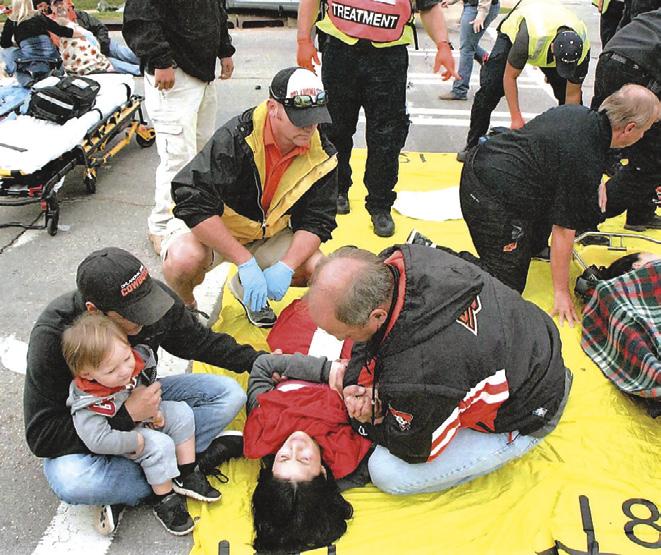
“I could no longer sit because the pain was unbearable, so I had to lie down,” Rodriguez said. “When people asked me where I was hurt, I don’t know why, but I started talking in Spanish, and no one could understand me.”
An “angel,” Mickey, was comforting her while another man fluent in Spanish was helping her communicate.
Cristian arrived shortly after that. He was distraught and couldn't understand what happened.
“I remember at that moment, I thought if I’m going to die, it’s okay because Jacob is with Cristian now,” Rodriguez said.
She was alert and able to talk, so medics transported other patients who appeared to be worse off — it ended up taking over an hour for her to get to the hospital in an ambulance.
At Stillwater Medical Center, doctors discovered her spine was broken, she had internal bleeding, and her leg was shattered in multiple areas. She had to be transported via helicopter to St. John’s Medical Center in Tulsa for treatment. After one week in St. John’s and three weeks in the rehab unit at Stillwater Medical Center, Rodriguez was able to go home.
Over the next four years, she endured four surgeries and years of physical therapy. They would be a challenging four years for her family, but there would be bright spots, as well.
26 IMPACT 2019
At the scene of the Homecoming crash on the morning of Oct. 25, 2015.
On September 25, 2017, the couple welcomed daughter Emily to the world. Like her big brother, she attends the Child Development Laboratory on campus. “She’s another miracle because my injuries were still so bad,” Rodriguez said.
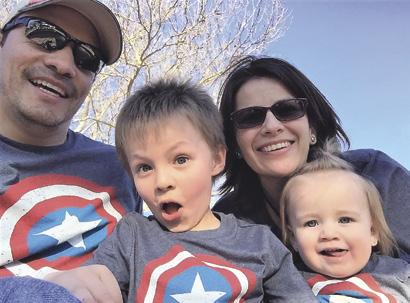
“I know it is amazing that I survived. I know it’s amazing that Jacob survived. I know it’s amazing that we had a daughter during all of this. But it’s so sad that four people died. They were not so lucky to have a happy ending. We have a happy ending, but the families who lost Nash, Nikita, Bonnie and Marvin do not. I think about them every single day. I also think about all the other survivors and their families whose lives were changed forever.”
Still Moving Forward
It has taken Rodriguez longer than she originally anticipated, but she aims to graduate with her doctorate in fall 2019.
“I learned that it’s good to set goals, but sometimes you have to be flexible,” she said. “Every morning I look at something I have framed in my bedroom. It says, ‘We must be willing to get rid of the life we planned, so as to have the life that is waiting for us,’ by Joseph Campbell. I knew if I put my mind to it, I would do it.”
That strong mind advice from her mom holds a special place for Rodriguez. Each day is a challenge as she continues to heal. In spite of the tragedy, pain, sadness and loss, she will accomplish what she set out to do when she receives her Ph.D.
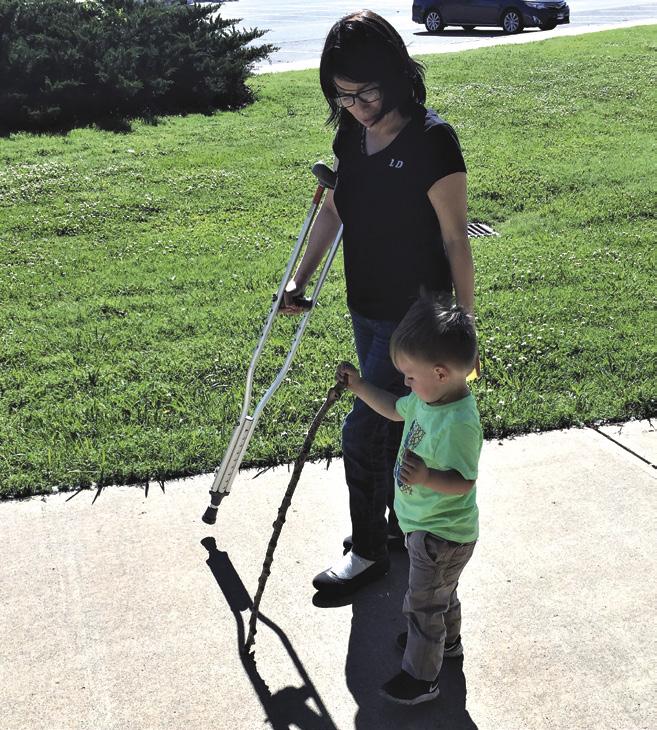
“For me, the true hero in all of this is Cristian,” Rodriguez said. “He is my hero. He took care of our son, our home and me. He had to take care of everything.”
Rodriguez hopes to stay in Stillwater after she graduates. They are an OSU family of four now, and she sees this as their home. Cristian is a utilities engineer for Facilities Management Energy Services. Diana dreams of working in improvement processes and optimization or perhaps teaching engineering students to develop soft skills. She can also see herself possibly working in a hospital setting, improving processes for patients.
“For me, the true hero in all of this is Cristian. He is my hero. He took care of our son, our home and me. He had to take care of everything.”
— DIANA RODRIGUEZ
OSU COLLEGE OF ENGINEERING, ARCHITECTURE AND TECHNOLOGY 27
CEAT by the Numbers
50%
of all CEAT students graduate with zero student loan debt
58
CEAT students receive scholarships each year
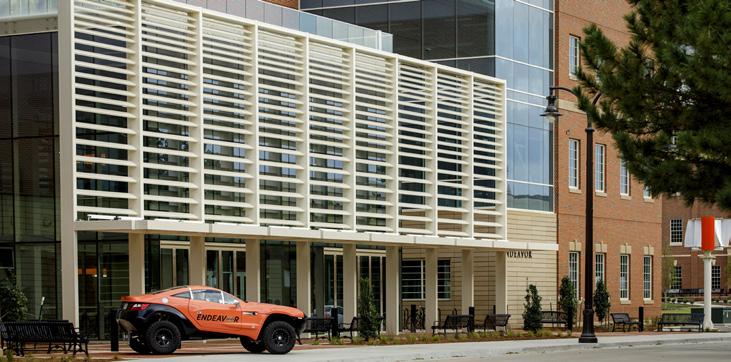
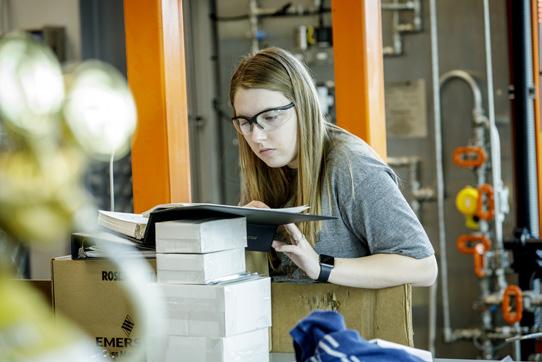
More than 1,200 Faculty
162 Full professors
$2.4M
2,144 Underrepresented students enrolled in scholarships were available for the 2018-2019 academic year
4,578 Student enrollments
non-debt financial aid awarded to CEAT students
CEAT researchers received over $16.6M

Over $27M in R&D funding last year
Over 350
undergraduate and graduate students participate in CEAT research each year
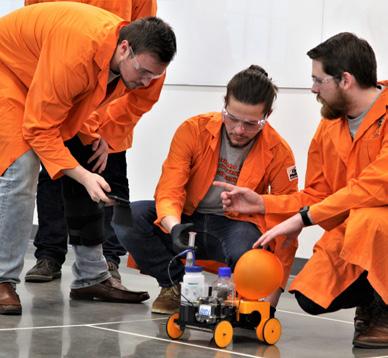

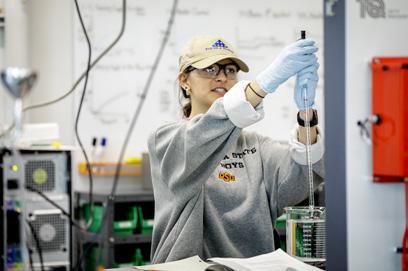
Educating students from 42 U.S. States & 48
Countries
Ranked 16
in the nation by U.S. News and World Report for Best Online Engineering Graduate Degree Programs


Industry magazine recognizes Ley’s fervor for concrete
Dr. Tyler Ley’s passion for concrete has propelled him into the spotlight in his industry. Ley, a professor of civil and environmental engineering at OSU, has now been named among the “Most Influential People in the Concrete Industry” by Concrete Construction magazine.
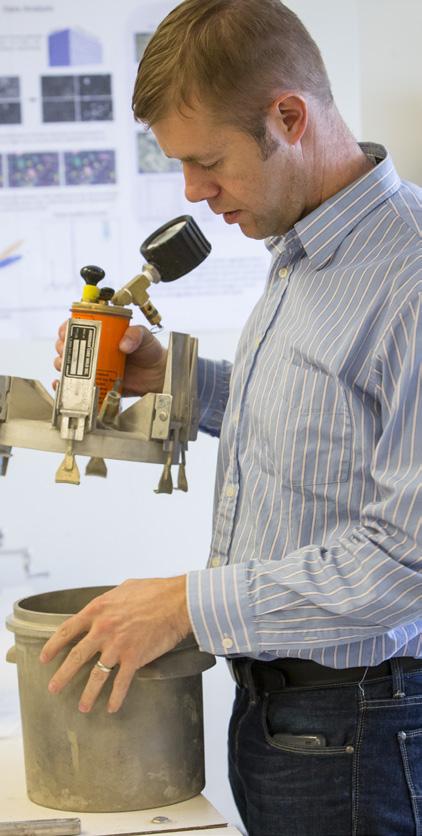
Ley has published over 200 educational videos on his YouTube channel that have been viewed more than 533,000 times by more than 7,700 subscribers. His channel is about concrete, “the greatest material in the world,” as he calls it.
“I am passionate about concrete,” Ley says on his YouTube introduction. “I think concrete is one of the most underappreciated wonders, and I am excited about helping others learn about it.”
Concrete Construction magazine has been serving the industry for more than 50 years.
OSU wins FAA approval to fly drone swarm
Oklahoma State University’s Unmanned Systems Research Institute was the first in the country to receive approval from the FAA to fly an unmanned fixed-wing aircraft swarm within national airspace. Current FAA regulations require one pilot and one set of controls for every unmanned aircraft. This flight authorization will permit a single pilot — along with visual observers for safety — to operate a swarm of up to 20 fixed-wing unmanned aircraft.
Dr. Jamey Jacob, professor of mechanical and aerospace engineering and director of the institute, said
research started four years ago to prove that flying a swarm of unmanned fixed-wing aircraft was possible.
The unique configuration developed by OSU researchers creates a “swarm of swarms” where groups of unmanned aircraft fly within smaller flocks as part of a larger swarm, communicating with a local group leader that coordinates flights with the overall swarm formation. The research could benefit environmental and infrastructure monitoring, agriculture, package delivery, national security, airspace operations and weather research.
Jacob said unmanned aircraft swarms could gather information about thunderstorms not currently available. Aircraft flying in formation could gather data about temperature, pressure and humidity. A swarm of unmanned aircraft could also map a wildfire, providing a comprehensive picture of its movement and intensity. Using a swarm could also save money. A group of aircraft measuring gas levels around an industrial plant, for example, could complete a job in hours that would take a single pilot and aircraft days.

CEAT BYTES
30 IMPACT 2019
Kak to receive top honor from India
Subhash Kak, Regents Professor Emeritus in electrical and computer engineering at Oklahoma State University, will receive the Padma Shri award from the president of India, the India Ministry of Home Affairs recently announced.
The Padma awards are India’s highest civilian awards, recognizing distinguished contributions in the arts, education, industry, literature, science, sports, medicine, social service and public affairs.
Technology winners from outside India have included Bill Gates of Microsoft in 2015, and former Cisco Systems CEO John Chambers and Adobe CEO Shantanu Narayen in 2019.
Kak joined OSU in 2007 as head of the computer science department before transferring to electrical and computer engineering in 2014. His research focus is in artificial intelligence, cryptography, neural networks and quantum information. He has developed new codes for computing and cryptography, worked on a variety of problems on data and network security, and he is the originator of one of the two methods of quantum cryptography. He retired from OSU in January.
Industrial center
marks 1,000th audit
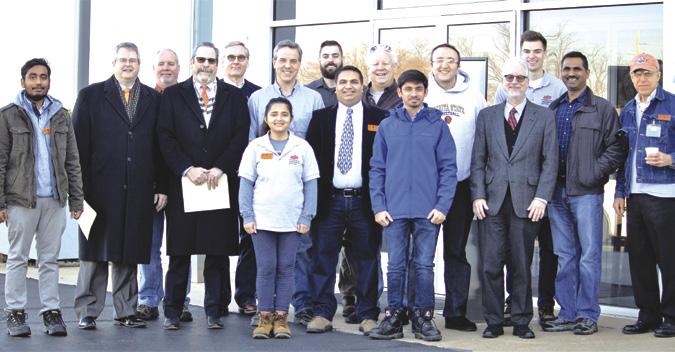
Late last year, a crowd turned out to celebrate a milestone by OSU’s Industrial Assessment Center.
On Dec. 4, 2018, the celebration marking the center’s 1,000th industrial assessment/energy audit drew team members, acting and retired faculty, OSU administrators and officials from the U.S. Department of Energy, Rutgers University and Wichita State University. The industrial assessment/energy audit was performed the following day at ASCO Aerospace.
The IAC helps small and medium-size manufacturers save energy, improve productivity and reduce waste with no-cost technical assessments. For more information about OSU’s IAC, visit iac.okstate.edu.
OSU’s Stine wins $1.5M grant


Computer engineering professor and Earl and Carolyn Glimp Professor of Engineering James Stine has been awarded the first phase of a threeyear, $1,504,372 research grant from the U.S. Air Force to design low-energy, high performance, application-specific computer architecture.
The award is part of the Air Force’s Future Autonomous Battlespace RF with Integrated Communications Project, a transformative communication program appropriate for access/area denial environments. The goal is to provide combat-ready, cyber-hardened, power-efficient embedded computer architectures.
OSU COLLEGE OF ENGINEERING, ARCHITECTURE AND TECHNOLOGY 31
Outside the Box
Alumnus Lee Easton credits OSU for his success-oriented work ethic
Oklahoma State University
alumnus Lee Easton is a man of many hats. With two bachelor’s degrees, four companies and a full-time engineering job, he knows what it means to work hard. He developed this mindset as a student in the School of Electrical and Computer Engineering at OSU.

Easton tried several different majors at OSU before ultimately finding his place in ECE.
“I did some reading and soulsearching to ultimately find that I wanted to do things that would leave behind a positive impact and inspire others the way that I had been inspired,” Easton said. “I felt like technology was the best route to take.”
Easton felt he had to work twice as hard as his classmates to keep up in college. But he believes that made him a better person.
“Halfway through my sophomore year of college, I switched to ECE,” Easton said. “From then on, for the next four years of school, I was on campus from 8 a.m. to 12 a.m. every single day — yes, 16-hour days. I eventually just got used to this and realized this is what it would take for me to keep up.
“I saw graduation as the end goal and thought of living a normal life with eight-hour workdays. Oh, how I was wrong — it's the life of an entrepreneur. All that being said, I would have never developed this work ethic if it hadn’t had been for the switch into the ECE program.”
One of Easton’s first impressions of ECE was a hands-on learning experience that seemed tailored to his learning style.
Easton remembers his intro to engineering class fondly. “We built Styrofoam boats with a single electric motor. The goal was to split into teams and design the best craft to make it the furthest distance. Right off the bat, we were learning about teamwork, design practices, budget, timeline and documentation. These are all skills that are important in any career. For me, it was the hands-on learning practices like this that made the School of Electrical and Computer Engineering stand out over the others. Now I visit campus, and I see the ENDEAVOR Lab. Why would anyone not want to go here?”
Easton graduated with two bachelor’s degrees in computer engineering and electrical engineering in May 2014.
Since graduating, Easton has had a full-time engineering job at ConocoPhillips and founded four companies. His two favorite companies are Aerovision.io and ModernBlox. Aerovision.io is a tech-based marketing company that helps businesses around Tulsa collect data on their processes and converts that data into cost-saving opportunities.
At ModernBlox, Easton (vice president) designs and builds commercial and residential properties
STORY CEAT MARKETING | PHOTOS COURTESY OF LEE EASTON
ALUMNI 32 IMPACT 2019
out of shipping containers with two other OSU alumni, Ben Loh and Swapneel Deshpande.
“I almost switched my major in college to architecture. ModernBlox has helped me scratch that itch,” Easton said. “We recently built a 1,600-squarefoot custom car garage out of five 40-foot shipping containers for a client in Tulsa who collects classic cars. We called it #AutoBlox. We have done projects from Tulsa all the way to Detroit, Michigan, and Atlanta, Georgia.”


Easton said the quality that most differentiates the School of Electrical and Computer Engineering is its people.
“I had the best experience developing great relationships with my professors and my classmates,” he said. “This was probably the best part of the whole college experience for me. The ECE department felt like my second family. I could walk into any professor’s office any time I wanted to ask a question.”
For future and current ECE students, Easton stresses the importance of building relationships.
“Now that I am out of college, I cannot stress how important networking is,” he said. “Relationships have proven to be so important in the past four years of my life after graduating from OSU. I simply would not be where I am today if it weren’t for some of the amazing people I’ve met along the way.”
OSU COLLEGE OF ENGINEERING, ARCHITECTURE AND TECHNOLOGY 33
Engineering Success
OSU'S first female graduate in her field credits her ability to adjust
Adapt. Ruth Spivey has taken that word to heart throughout her 94 years. But when she graduated from OSU more than 70 years ago, adapting wasn’t a choice. It was a requirement.

Spivey was born in Ripley, Oklahoma, and eventually moved to Stillwater with her parents. She was always fascinated by math and science.
“I was kind of a weird little kid,” Spivey said. “I can remember before I started school, I wanted boys’ toys. My loving grandfather bought me a little steam engine and an electric train. I was always interested in that sort of thing.”
This fascination led Spivey to attend OSU (then Oklahoma A&M College) as an electrical engineering student during World War II.
“My classes were very small because most of the guys got drafted,” Spivey said. “I think that was one of the reasons I did fairly well. The classes were so small, and I got a lot of individual attention.”
At OSU, Spivey was a member of Sigma Delta, an organization designed to stimulate interest and encourage scholastic achievement of the women enrolled in engineering through closer association and mutual assistance.
“We supported each other,” Spivey said. “If we felt overwhelmed, we would boost each other up.”
Spivey graduated in 1945 as the first woman to earn an electrical engineering degree from OSU.
Before she began her career, Spivey received some advice from a mechanical engineering professor that stuck with her.
“He told me I was entering a man’s world. Adapt. Don’t try to change it,” she said.
While working her first job as a test engineer for General Electric, Spivey met her husband, Frank. The couple would have three children together: Margaret, Harold and Patricia.
Marriage and having children led to more adapting as Spivey continued to pursue her career.
“Back in that day, women could not work if they were pregnant,” Spivey said. “There were periods of time when I didn’t get a chance to work. Also, after we got married, Frank and I couldn’t work in the same building for GE.”
None of this stopped Spivey from taking jobs across the country for the next five decades as the family moved because of Frank’s position.
STORY WILL CARR | PHOTOS OSU ALUMNI ASSOCIATION
“I think it is extremely important to work on something you are excited about. It’s not hard to get along with people if everyone is excited and shares a common goal.”
ALUMNI 34 IMPACT 2019
One of Spivey’s proudest accomplishments was doing the surveying and assisting with the location map for the Interstate 10 bypass around Benson, Arizona, while she worked for the Arizona Highway Department.
Eventually, Spivey would land multiple positions for the U.S. Air Force in San Antonio. She worked for the Air Force in civil service for over 25 years, including as head of the base closure division for Air Educations and Training Command, in charge of nearly 50 other engineers.
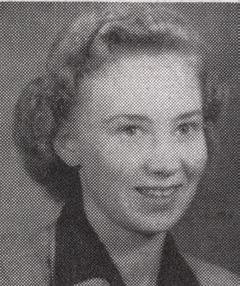

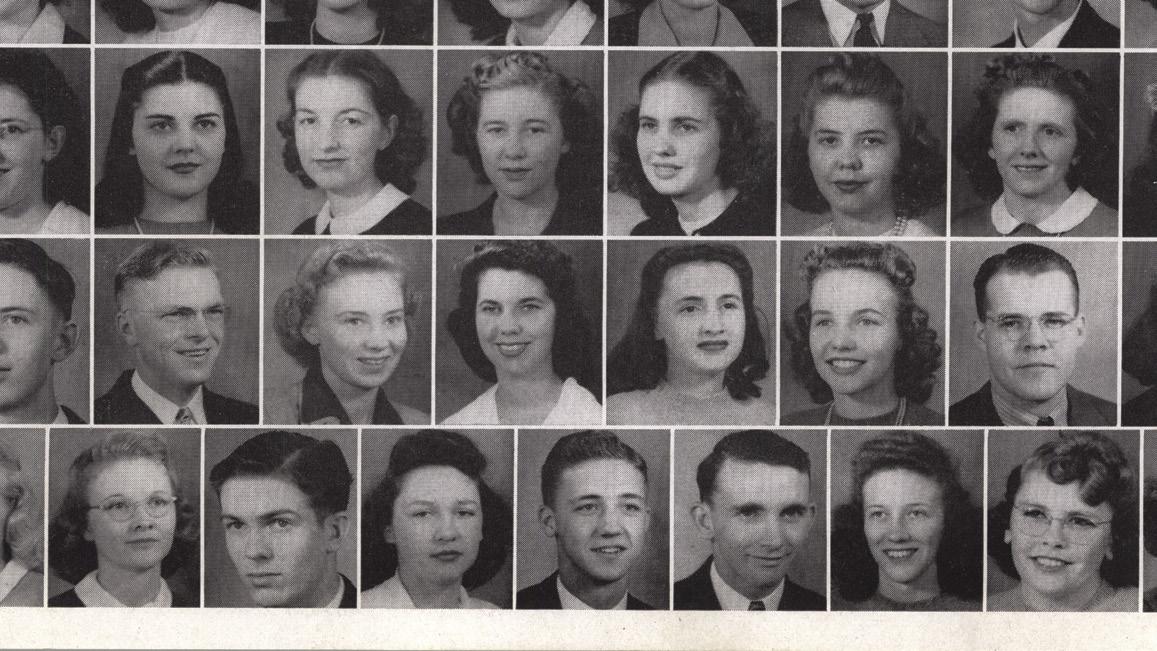
“I never felt like the men who worked for me were uncomfortable,” Spivey said. “I just treated them like I would have liked to have been treated.”
Upon retiring from civil service for the Air Force, Spivey was classified as a GS14 — the second-highest civilian rank.
Spivey now lives in a retirement home in New Braunfels, Texas, where she continues to support the university she loves. She hopes she can inspire women to reach for their goals.
“I think it is extremely important to work on something you are excited about,” Spivey said. “It’s not hard to get along with people if everyone is excited and shares a common goal.”
Ruth Spivey (lower left) poses with members of Sigma Delta in 1945.
OSU COLLEGE OF ENGINEERING, ARCHITECTURE AND TECHNOLOGY 35
Lessons From Bees
OSU researchers are seeking hints on swarming behaviors from insects
Imagine seeing swarms of drones quickly fly over the path of a miles-long tornado looking at heat signatures for signs of life. Or unmanned, aerial vehicles autonomously lining up to enter a home window while searching for victims.
An Oklahoma State University researcher is in the early stages of studying groups of honey bees in hopes of determining if their flight paths could be useful in a wide variety of industries, including helping future swarms of autonomous drones better work as cohesive units.

Dr. Imraan Faruque, mechanical and aerospace engineering assistant professor and director of the autonomous physics group at OSU, is thrilled to be doing the research with
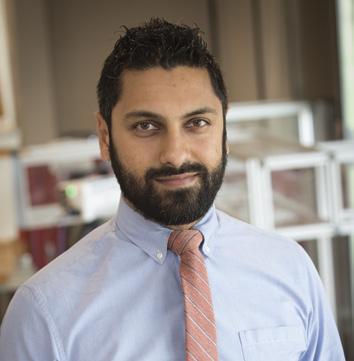
help from a few students and a postdoctoral researcher.
“We will be collecting experimental flight data in crowded assemblies, both body trajectories and wing motions, which will provide a powerful validation tool to test our theoretical models against,” Faruque said.
The Office of Naval Research selected Faruque as one of 25 earlycareer professionals for its 2019 Young Investigator Program. The award comes with up to $750,000 in funding over three years.
Faruque’s project, titled Insect Group/Swarm Behaviors and their Relation to Individual Feedback Models, will contribute to the Office of Naval Research’s Science of Autonomy program.
“In this project, we will extend my theoretical and experimental neural function extraction work from individuals to groups and swarms of insects. This will allow us to address some challenges in practical aerial swarms by studying how insects use their limited neural resources to achieve robust, autonomous, group and swarm behaviors,” he said. “Many insects don’t see the world like you and I do. They sort of see this blurry, out-offocus version. What they are actually responsive to is motion patterns.”
Sophomore Ethan Lane is fascinated with bees and had his own hives as a youth in Lawton, Oklahoma.
“Almost every insect has something unique about it that we can use and leverage to improve our technology,” Lane said. “It is already there; we just have to go and study it.”
RESEARCH STORY DAVID BITTON | PHOTOS PHIL SHOCKLEY AND DR. IMRAAN FARUQUE 36 IMPACT 2019
Dr. Imraan Faruque (above and below) works with honey bees.
During the spring semester, Lane built a tunnel that bees could fly through so they could be studied and recorded.
“The first task was to figure out what size the tunnel needed to be,” Lane said. “If a bee is feeling too confined, it will walk. If the tunnel is too big, the bee won’t be in a controlled trajectory. We settled on an 8-inch by 8-inch ‘Y’ maze that allows the bee to leave the hive and then split left or right.”
The goal is to study the detailed mechanics of in-flight interactions as insects navigate spatial decision making tasks. For example, deciding which tunnel to exit based on learned positive or negative responses to color and other visual stimulus and how those interactions change as more members are introduced.
“Anything that we want to model on the bee and study about its flight, we won’t have to wait for these things to happen — we can tell the bee to turn left, and we can get video of that turn,” Lane said.
The lab is equipped with nearinfrared lighting and four video cameras capable of recording at least 9,000 frames per second in 1080 highdefinition quality.

Doctorate student Arif Billah, from Bangladesh, is focused on analyzing the footage and drawing conclusions.
“We are trying to learn how bees communicate between each other and how they make decisions,” Billah said. “Once we know more about them, we can apply our own form of robotic bees to control how they behave.”

That’s right: OSU is working on a prototype for a fake bee.
“Part of my job as an adviser is to figure out what students are curious about and figure out a way to make that society-relevant in a way that solves some of today’s big challenges,” Faruque said. “I want people who are passionate working on a particular problem. This is a process where you need that selfdiscovery and that motivation. You sort of need to have your own curiosity.”
Researching bees leads to new insights. Top: Ethan Lane, Dr. Imraan Faruque, Austin Rolen, and Arif Billah work on an 8-inch tunnel for honey bees to fly in while being studied and recorded. Bottom: A queen and attendant bees are moved from a transition cage to a new hive off McElroy Road.
OSU COLLEGE OF ENGINEERING, ARCHITECTURE AND TECHNOLOGY 37

“(The autonomous truck corridor) … is a transformational opportunity.”
(
RESEARCH
— DR. PAUL TIKALSKY
)
38 IMPACT 2019
STORY DAVID BITTON | PHOTOS GARY LAWSON, PHIL SHOCKLEY AND NICOLA MOTOR CO.
Real Truck Lanes
Tikalsky and Ley propose building autonomous truck corridors to support 21st century transportation needs
Imagine an interstate highway system with less traffic, better safety and longer-lasting roadways.
That’s what two Oklahoma State University researchers are developing while tackling how to rebuild America’s interstate infrastructure for the 21st century.
“I have dedicated my life to improving roads and bridges,” said Dr. Tyler Ley, structural engineering professor in OSU’s School of Civil and Environmental Engineering. “Our roads are in pitiful shape.”
Proposed Solution
Ley and Dr. Paul Tikalsky, dean of OSU’s College of Engineering, Architecture and Technology, are proposing building independent roads next to existing highways for autonomous and electric-powered self-driving freight trucks, calling the lanes autonomous truck corridors.
These separate lanes could hold much more weight, allow autonomous trucks to travel at higher speeds, save energy by traveling closer together and provide trucking companies with a reliable way to move their products. Overhead electric and fiberoptic lines would power and monitor the trucks.
Benefits could include quicker and more reliable delivery times and lower greenhouse gas emissions.
“The technology needed to make all this happen already exists,” Tikalsky said.
Tikalsky has worked on a wide variety of transportation and infrastructure projects throughout his career and sees the Midwest and southern Plains as the freight, energy, trade, transportation and information backbone of the nation. He has met with the Senate Appropriations Committee in Washington, D.C., to propose the autonomous truck corridor.

“We aren’t the only ones thinking about this, but someone has to start it,” Tikalsky said. “It is time for a national effort to build cohesive and enduring infrastructure corridors that provide our nation with economic and sustainable transportation, and utility and information corridors that drive commerce and security for the next century.”
Partnership
OSU has partnered with Pennsylvania State University and University of North CarolinaCharlotte to help the autonomous truck corridor become a reality. One of the group’s proposals is to create a University Transportation Center in Stillwater, where experts from private industry, government agencies and academia would work together to do just that.
“This corridor will require a new way of thinking in the design, operation, maintenance
Nicola’s Tre model (left) is a fully-electric and hydrogen fuel cell electric day cab semi truck.
DR. TYLER LEY
OSU COLLEGE OF ENGINEERING, ARCHITECTURE AND TECHNOLOGY 39
and financing of transportation infrastructure,” Tikalsky said. “Our team has written support from dozens of companies, four DOTs (departments of transportation) and turnpike authorities. People who think this is 10 or 20 years out could be grossly mistaken. We could build 100 to 200 miles within a few seasons.”
Tikalsky has suggested building an autonomous truck corridor on Interstate 44 between Oklahoma City and Tulsa to show that the concept works with existing technology.
Tikalsky, previously the deputy director of the Larson Transportation Institute at Penn State, was involved in a multimillion-dollar project to build a 10-mile stretch on Interstate 99 in Pennsylvania that cost the same as a traditional road but would last 100 years. Tikalsky said it is still in great shape nearly 20 years later.
BY THE NUMBERS
■ 71% of the nation’s freight is moved by trucks
■ 78% driver turnover among large fleets
■ 3.5 million truck drivers (2018)
■ 3.68 million heavy trucks (including tractors and straight trucks) in operation (2016)
■ 10.77 billion tons of freight transported in primary shipments (2017)
■ 181.5 billion miles traveled by combination trucks (2017)
■ $700.1 billion in gross freight revenues (primary shipments only) (2017)
SOURCE: American Trucking Associations
“This current proposal would not have been possible without the experience of developing this (Pennsylvania) corridor,” he said. “A substantial effort of this previous work was to convince owners, designers and contractors that it is possible and practical to do something better than what they do now.”
Oklahoma took its first steps toward becoming an autonomous vehicle leader in May when Gov. Kevin Stitt signed a bill into law that gives the state control over all legislation affecting autonomous vehicles. The Oklahoma Department of Transportation is currently looking at future policies.
“This makes it even easier for the autonomous truck corridor to happen in Oklahoma,” Ley said.
The Need
The 1956 Federal Aid Highway Act that paved the way for the creation of 41,000 miles of roadways across the country was a game-changer for commerce and travel.
But the U.S. is now faced with an aging infrastructure that Ley said receives less than half of the estimated $170 billion needed annually to address deteriorating conditions and reduce congested roadways to safe levels.
“I am tired of incremental changes,” Ley said. “We need a massive, huge, game-changer approach.”
Tikalsky agrees.
“When we built the interstates, it gave us a huge commercial advantage to all other countries,” he said. “How do we build this spine that allows our freight for the 21st century? If we do it, we would really be the envy of the world.”
Function and Funding
Tikalsky and Ley envision building autonomous truck corridors in high-demand freight traffic areas throughout the country. A single corridor spoke into a city would get the trucks to a central facility for local drivers to complete the deliveries.
By creating these corridors, Ley envisions many of today’s 3.5 million truck drivers being able to work in their communities and sleep in their own beds, thus reducing the shortages and high turnover in the trucking industry. It is not known how many jobs may be lost.
The corridor could pay for itself and generate income through tolls.
“The autonomous truck corridor will generate the revenue necessary to support its own construction and maintenance, and potentially many infrastructure projects,” Tikalsky said. “This is a transformational opportunity.”
40 IMPACT 2019
BENEFITS
The estimated benefits of autonomous truck corridors include:
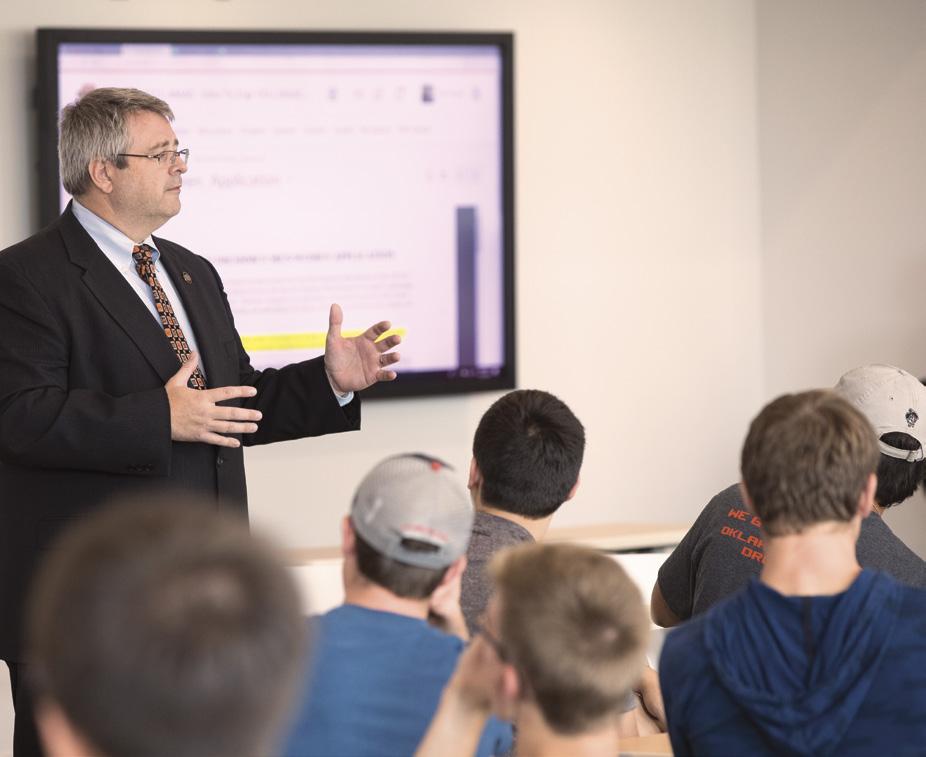
■ 75% reduction in heavy truck traffic on the highway system
■ 50% longer lifespan for current highways
■ 50% less energy needed for heavy freight shipping
■ Improved driver safety
■ Added security corridors for use during emergencies
Dean Paul Tikalsky lectures to first-year engineering students.
“This corridor will require a new way of thinking in the design, operation, maintenance and financing of transportation infrastructure.”
OSU COLLEGE OF ENGINEERING, ARCHITECTURE AND TECHNOLOGY 41
— DR. PAUL TIKALSKY
A Dolphin Project … in Oklahoma
OSU researchers seeking way to measure dolphins’ stress and health

RESEARCH
STORY PATRICK WHEELER | PHOTOS COURTESY OF AARON ALEXANDER , RICK GAETA AND JASON BRUCK 42 IMPACT 2019
OSU graduate students Mitch Ford, Chris Barton and Tabby Gunnars attend to an acoustic playback test set up near a dolphin lagoon in Bermuda.
Given Oklahoma’s notoriously unpredictable weather, it might be no surprise that the Unmanned Systems Research Institute at Oklahoma State University is working with climate experts to improve forecasting.
But it might be a surprise to learn that the institute and other researchers in OSU’s College of Engineering, Architecture and Technology and its College of Arts and Sciences (CAS) are playing a role in research on dolphins.
Assistant professor Rick Gaeta of the School of Mechanical and Aerospace Engineering; associate professor Aaron Alexander of the Division of Engineering Technology; professor Jamey Jacob, director of the Unmanned Systems Research Institute; and teaching assistant professor Jason Bruck of Integrative Biology in CAS are teaming up to find ways to measure stress and health in wild dolphins affected by human disturbance.
“The overall research objective is to be able to understand, capture and measure dolphins’ stress levels in a wild environment that are due to a variety of things,” Gaeta said. “But most importantly, human-made factors in the ocean such as industrial oil extraction, shipping noises, military sonar and other sounds can affect their stress levels.”
Researchers can measure stress by analyzing the hormone cortisol, which dolphins — like all mammals — have. “The trick is how do you actually collect this cortisol on a dolphin in the wild without causing it more undue stress?” Gaeta said.
Dolphins breathe from a blowhole, and each breath is much like a person’s sneeze, laden with fluids.

Collecting this dolphin snot is equivalent to a mucus or saliva sample taken from a human patient. Taking a blowhole sample from a dolphin in the ocean is quite a challenge. That’s where Gaeta’s and Jacob’s expertise with unmanned aerial vehicles (drones) comes in.
Drones have captured cortisol samples from large whales, which are much slower and generally not spooked by a buzzing drone. However, dolphins are more agile and more likely to react negatively to the buzzing sounds of a drone. The challenge becomes designing a quiet drone that will not scare the dolphins.
Dr. Jason Bruck, a dolphin researcher from OSU’s Department of Integrative Biology, explains: “Using controlled experiments with dolphins under human care and the introduction of differing drone sounds above water played from a speaker, we are looking for things like how long the animal spends under water as a measure for how well they can hear the devices. We are also looking for things like how long they pair up, which is basically a sign that they need to regroup and swim together. We look at all those types of behavior as indicators that the animals are not only perceiving the drone sounds, but they are also reacting to it.”
in the wild. (Photo provided by Haley D.
assistant professor, Department of Anatomy and Cell Biology, OSU Center for Health Sciences)
OSU COLLEGE OF ENGINEERING, ARCHITECTURE AND TECHNOLOGY 43
A MicroCT scan of a dolphin head housed within the OSU Collection of Vertebrates. The blowhole nasal passage, through which the dolphin breathes, is highlighted in purple. OSU scientists are using this image to help model the dolphins’ breathing to help build drones that can collect hormones from dolphin blowhole exhalations
O’Brien,
Gaeta adds that not all drones sound alike. Some sound like “a swarm of bees” due to small high-speed rotors while others can sound more like a large fan. Also, whether the drone is a multirotor vehicle or a fixed-wing aircraft with a single propeller can make a big difference in the sound.
Another challenge to successful hormone collection involves defining the dolphin’s vision. Even if a drone is quiet, a dolphin may still see it approaching and take evasive maneuvers.
breath with Computational Fluid Dynamics, which will be used to compare and extend Particle Imagery Velocimetry measurements made in Jacob’s lab. The models will allow the researchers to examine how the breath plume is affected by the dolphin swimming at 20 mph. In order to accurately model the dolphin breath plume, it is critical to use the actual anatomical geometry. Dr. Haley O’Brien, assistant professor in the Department of Anatomy and Cell Biology at OSU’s Center for Health Sciences, has created a three-dimensional scan of the internal anatomy of an actual dolphin head. By using cutting-edge microCT technology, O’Brien captures X-ray images that let the team peer into dolphin anatomy with a degree of magnification finer than a human hair, providing the highest precision model of dolphin anatomy.
Before this collection can be attempted in wild animals that are protected by both federal and international regulations, it must first be proven safe for the dolphins. That’s why Gaeta and Jacob, along with mechanical engineering undergraduate students have designed a static piston-based mechanical simulator to replicate a dolphin’s respiratory system. Replicating the size and velocity of expectorant from the blowhole brings the biology side into play with Bruck, in cooperation with the OSU Collection of Vertebrates and its animal samples, providing estimated blowhole exit velocity data of 73 feet per second.
“The other thing we are working on is defining the visual field of the dolphin,” Bruck said. “We do not know where the dolphin’s blind spots are. They have eyes on the opposite sides of their heads, and we think they are pretty good at seeing things from the sides, but we hypothesize that they have a blind spot above their heads based on behavioral anecdotes taken from those who work with dolphins on a daily basis. However, we have never systematically studied that, so this is one of the things we are studying this summer in Bermuda at our partner facility Dolphin Quest. We will be looking at where the blind spots of the dolphin are so we can position collection devices where we want them without startling the animal.”
Gaeta is trying to understand the dolphin’s respiration rate. A dolphin’s very fast 0.3-second natural inhale/exhale breathing mechanism can be extrapolated to the engineering principal of jet dynamics. Specifically, dolphin breath looks like a two-phase jet exhaust or a combination of air and a saliva/seawater mixture. To help model the dolphin’s breath, Alexander will use his computational expertise to model the dolphin
In other words, a quiet drone will eventually have to track down a dolphin traveling 20 mph, with a goal of catching its blowhole exhalation sample while the exhaling lasts for all of about 0.3 seconds.
Not only must the researchers figure out how to get the samples from the dolphins — they have yet to know how big of a sample they need to get the needed concentrations of cortisol.

“What is the minimal concentration of cortisol needed to determine where the drone needs to be positioned to collect the appropriate amount of dolphin mucus?” Gaeta said. “Is that a foot above, 10 feet above? Is it only in the first inch above the water? How big is the sample? How quickly does it dissipate? Data from captive dolphins, which will lead to accurate modeling and simulation, will help answer these questions. All these variables are going to define the concept of operation and design of this specialized drone.”
“I think the takeaway from this is it is an interdisciplinary collaboration,” Jacob said. “There are CEAT undergraduate senior design students working on components that will be used in research by graduate students. It expands not only in different areas, but also on different research
44 IMPACT 2019
Kelly Winfield, animal care specialist at Dolphin Quest Bermuda, asks the dolphin to “sneeze” to produce the mucus mist needed to estimate the velocity of lung particles.
levels. This is the kind of multidisciplinary activity USRI was designed specifically to support.”
Gaeta draws an even bigger picture: “You can also look at this project as a subset of a larger research area that focuses on the interaction of drones and the animal kingdom. As humans, we are just now dealing with the impact of how drones affect our daily lives. This will happen with drones and animals, as well. Drone interactions with livestock or birds will become more important. OSU has strong research programs in both unmanned aerial systems and animal behavior that make it uniquely qualified to be a leader in this field. This will be part of a larger story.”
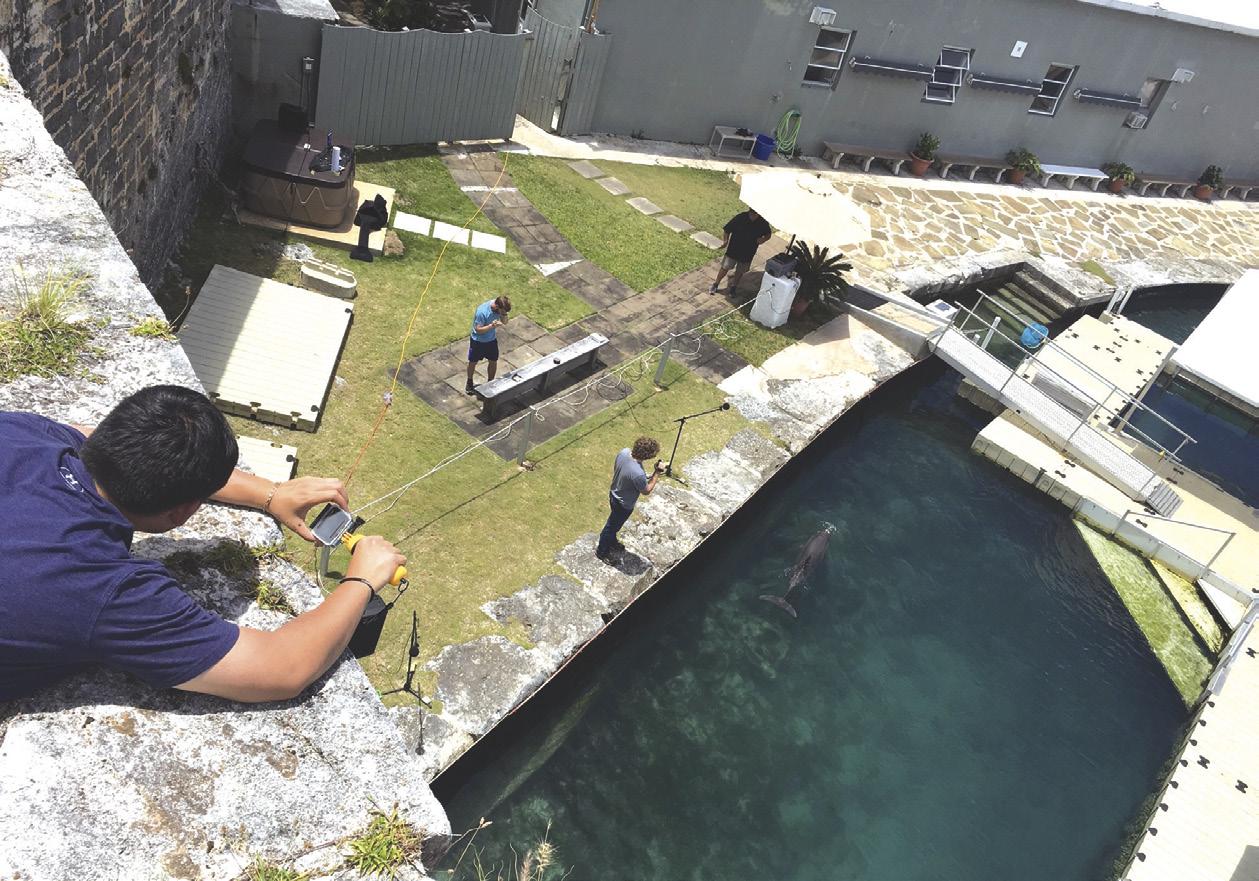 OSU graduate students Alvin Ngo, Mitch Ford and Chris Barton monitor dolphin behavior as drone playback is presented to them.
OSU graduate students Alvin Ngo, Mitch Ford and Chris Barton monitor dolphin behavior as drone playback is presented to them.
“Oklahoma State University has strong research programs in both unmanned aerial systems and animal behavior that make it uniquely qualified to be a leader in this field.”
OSU COLLEGE OF ENGINEERING, ARCHITECTURE AND TECHNOLOGY 45
— DR. RICK GAETA

46 IMPACT 2019
Copper Catalysts
Chemical engineering researchers study ways to cut industrial production costs
In the ever-changing pharmaceutical industry, the heavy metals palladium and platinum have ruled as kings of the catalysts in development processes. However, an Oklahoma State University research team led by assistant professor Dr. Marimuthu Andiappan is working to transform the pharmaceutical and chemical industries by using less expensive copper-based catalytic materials.
“Catalysts are materials that can activate a chemical bond and speed up the reaction without being consumed in the process,” said Andiappan, a faculty member in the School of Chemical Engineering in the College of Engineering, Architecture and Technology. “Traditionally, most of the active pharmaceutical ingredients are being produced in an expensive and toxic palladium-catalyzed homogeneous batch process. This is cumbersome, time-consuming and capital-intensive.”
Akira Suzuki, a Japanese chemist who published his findings in 1979, is credited with the discovery and development of the palladiumcatalyzed cross couplings in organic synthesis. He, along with Richard Heck and Ei-ichi Negishi, won the Nobel Prize in chemistry in 2010. Roughly 70 percent of pharmaceuticals are manufactured using the palladium-driven process.
Andiappan and his team, first-year doctoral student Sundaram Ramakrishnan, second-year doctoral student Ravi Teja A.T. and third-year doctoral student Farshid Mohammadparast have been conducting fundamental research on copper-based materials through a health research grant awarded by the Oklahoma Center for the Advancement of Science and Technology.
“We are researching and developing low-cost copper-based nano-catalysts,” Andiappan said. “During this process, we’ve discovered several other characteristics that may be useful across other applications.”
His approach is to perform research at the fundamental and molecular level, then analyze how it can be applied in industry.
STORY JESSICA STEWART | PHOTOS GARY LAWSON
“During our journey, we have found that copperbased materials have the ability to exploit the magnetic properties of light,” Andiappan said. “These singular characteristics can be used in a new territory of materials called ‘metamaterials.’”
Metamaterials are a class of engineered materials designed to contain properties that don’t occur naturally. Andiappan says metamaterials can be tuned to generate properties such as artificial magnetism, negative refractive index finding applications like subwavelength resonant cavities, and sub-diffraction limited near-field lenses (also known as superlenses). They can also have other advantageous properties such as acting as phase compensators, a high refractive index, tunable chirality or smart metamaterial cloaking. They can also be used in plasmonic color printing and optical data storage.
Andiappan and his team are focused on industry applications, and they have interests in renewable and sustainable energy, communications and sensors. They’re excited about their findings.
“During the synthesis of the copper-based nanocatalyst, we found unique optical properties that can be explored, for example, in renewable energy applications,” Andiappan said.
Team member Ramakrishnan has focused on assisting with the synthesis of the catalyst and identifying novel photocatalytic properties.
“We have learned that the novel properties include harvesting a large fraction of the light, so this may be an excellent application for photovoltaic applications, particularly solar panels,” Ramakrishnan said.
Within the synthesis of catalyst materials, he is also evaluating the nanoparticles and their application at industry level. Ramakrishnan said he is identifying whether the process is cost-effective, whether it can be used at room temperature, and how nanoparticle geometry can be controlled.
RESEARCH
OSU COLLEGE OF ENGINEERING, ARCHITECTURE AND TECHNOLOGY 47
“We first are evaluating the light-scattering properties for photovoltaic applications,” Ramakrishnan said. “Utilizing this nanoparticle in solar applications, for example, could trap more light. Ultimately, perhaps it can be used in costeffective solar films that would be much lighter weight than today’s solar panels. This would be because there would be just one layer collecting and utilizing light, rather than the multi-layer solar panels that exist today.”
He is also evaluating metamaterials and light properties.
“As light falls, I’m trying to bend the light,” Ramakrishnan said. “Essentially what happens is the material goes invisible when light falls on it. It bends to negativity and goes to invisible. This could be applied to nanoantennas used in communications with less attenuation.”
Yet another research focus area has been on the concept of continuous manufacturing in the pharmaceutical industry. Research team member Mohammadparast said the National Science and Technology Council has identified continuous manufacturing of pharmaceuticals as one of the top five manufacturing priorities in the United States. He has developed a process for real-time testing of the quality of drug molecules using “inline process analytical technology,” or inline PAT. This process utilizes UV-visable spectroscopy, which is considerably less expensive than the current inductively coupled plasma mass spectrometry, which can cost hundreds of thousands of dollars.
“This inline PAT is important because it will result in fewer batches failed and will reduce the time it takes to analyze drug molecules,” Mohammadparast said. “We can test the quality of the drug molecules and determine how well they are meeting the specifications or moving away from the specifications. Then we can take corrective actions in-house, rather than waiting for the sample to return from the testing laboratory.”
Mohammadparast and Andiappan estimate that this technology will be much more affordable for companies, allowing smaller pharmaceutical startups to obtain analytical technology and
reduce development time. The National Science and Technology Council indicates that continuous manufacturing processes could reduce the cost of pharmaceutical manufacturing up to 50 percent.
Andiappan’s team’s approach to the research has proven successful. Each of his graduate students on the team researches different aspects, and several students have been able to focus on their research passions. For example, Ramakrishnan has a passion for renewable energy and has been able to further explore his research interests within the overall project.
“I would like to work in the area of renewable energy so it could impact the lives of others,” Ramakrishnan said.
Team member Teja A.T. had previous experience in researching fuels and sustainable energy, which led him to Andiappan’s research.
“I am interested in contributing to the mission of solving the energy needs of the world,” Teja A.T. said. “My insatiable curiosity to understand the science behind common features of the ecosystem gradually evolved into a similar enthusiasm to explore the fields of plasmonic catalysis, which find a myriad of applications ranging from nanocatalysts in pharmaceuticals to nanoantennas in metamaterials. I have contributed to understanding reaction mechanisms when copper-based nanocatalysts are used and exploit its photocatalytic properties.”
While there are still many unknowns in copper catalyst research, Andiappan and his doctoral student team are garnering interest through their awards and journal publications. Mohammadparast presented his research on “Surface Plasmon Resonance Spectroscopy as a tool to determine amount of substrate leached atoms and catalytic pathway in C-C crosscoupling reactions” at the American Chemical Society’s spring 2019 meeting in Orlando, Florida.
Mohammadparast’s journal article, “C-C Coupling Reactions Catalyzed by Gold Nanoparticles:
Evidence for Substrate-mediated Leaching of Surface Atoms using Localized Surface Plasmon Resonance Spectroscopy” is featured on the May 2019 cover of The Journal of Physical Chemistry Two additional journal articles have been submitted and are pending acceptance.
48 IMPACT 2019

“During our journey, we have found that copper-based materials have the ability to exploit the magnetic properties of light.”
— DR. MARIMUTHU ANDIAPPAN
OSU COLLEGE OF ENGINEERING, ARCHITECTURE AND TECHNOLOGY 49
(From left to right) Ravi Teja Addanki Tirumala, Dr. Marimuthu Andiappan, Farshid Mohammadparast and Sundaram Bhardwaj Ramakrishnan
Early CAREER Recognition
Three CEAT faculty win prestigious NSF awards
Three faculty members in Oklahoma State University’s College of Engineering, Architecture and Technology have won the National Science Foundation Faculty Early Career Development (CAREER) Program award.
Jindal Shah and Ashlee Ford Versypt, assistant professors in the School of Chemical Engineering, and Shuodao Wang, an assistant professor in the School of Mechanical and Aaerospace Engineering, have been awarded the NSF’s most prestigious award supporting early-career faculty.
OSU’s chemical engineering school now has five faculty members who have received this award in the past 14 years.
Shah’s project, “CAREER: ComputationEnabled Rational Design of Cytochrome P450 for Ionic Liquid Biodegradation,” has been awarded $514,262 over the next five years. He received his doctorate from the University of Notre Dame and worked on his postdoctoral research at Ohio State University before returning to Notre Dame as a research assistant professor. He joined OSU in 2014.
Shah’s proposed research aims to generate foundational knowledge and computational methodologies that can be extended to engineer enzymes for biodegradation of novel solvents known as ionic liquids. He proposes integrating research and education by training high school chemistry and biology teachers and aspiring teachers from the OSUTeach program in using molecular editing and visualization tools, incorporating quantum calculations into a graduate-level course on modeling and simulation, and teaching undergraduate students how to utilize computation and visualization in their courses.
“[Shah] is quickly establishing himself as a leader in the field, as he was also recently named as one of 25 ‘Emerging Investigators’ in chemical thermodynamics by the Journal of Chemical and Engineering Data,” said Heather Fahlenkamp, professor and interim head of CHE. “The NSF CAREER Award is very well deserved, and I’m looking forward to his continued success.”
Ford Versypt's project, “CAREER: Multiscale Modeling of a Virtual Kidney during the Onset and Progression of Diabetic Kidney Disease,” has been awarded $550,000 for the next five years. She received her doctorate from the University of Illinois at Urbana-Champaign and performed her postdoctoral work at the Massachusetts Institute of Technology. She also came to OSU in 2014.
Ford Versypt’s project will develop a novel multiscale computational approach for studying diabetic kidney disease through a virtual kidney that can be used like a powerful, non-invasive microscope to detect and monitor damage to the glomeruli (where most damage occurs) during the onset and progression of diabetic complications. The computational tool will aid in understanding how diabetic kidney damage begins and changes over time. In the long term, results from this project will help predict the impact of many competing factors on kidney health during diabetes management.
The project will also involve a set of educational activities related to the scientific work. Several undergraduate and graduate students will work with her to conduct the research and educational activities. Educational modules related to the research will be delivered to a variety of groups, including K-12 students, college students, and grandparents through OSU's Grandparent University. Physical models of kidney tissues will be 3D-printed and shared with students and educators. The activities will expose many students and members of the public to biomedical engineering and computational science through engaging scientific demonstrations and interactive experiences.
“Dr. Ford Versypt is growing her reputation in research and engineering education,” Fahlenkamp said. “She was also recently selected as the recipient of an American Institute of Chemical Engineers 35 Under 35 Award for her achievements in engineering education.
Wang received his bachelor’s degree in engineering mechanics from Tsinghua University in Beijing in 2007 and his doctorate in mechanical
STORY AND PHOTO KRISTI WHEELER
RESEARCH 50 IMPACT 2019
engineering from Northwestern University in Illinois in 2012. He came to OSU in 2014.
This CAREER award will support Wang’s integrated research and educational efforts to generate new knowledge of how material and thickness non-uniformity (also referred to as heterogeneity) in thin, bio-compatible materials and bio-tissues affect their mechanical behaviors under various deformation conditions. Examples of such materials include ultra-thin wearable biosensors, the eardrum membrane and the heart valves. The award supports fundamental research to enable a currently unavailable, non-destructive material characterization protocol for obtaining the material property maps, which will allow better understanding of the deformation and stability of these materials. The innovative approach in this project is expected to promote scientific advancement in new mechanics knowledge that is important for a wide range of health care and biomedical applications, thereby benefiting the national health and economy.
The project will provide opportunities to train students in interdisciplinary areas of mechanics, materials science and biomedical devices. The educational outreach activities are designed to engage young children and underrepresented minorities in STEM education to try to enlarge the national STEM talent pool.
The CAREER Program offers the NSF’s most prestigious awards in support of early-career faculty who have the potential to serve as academic role models in research and education and to lead advances in their departments or organizations. Activities pursued by early-career faculty should build a firm foundation for a lifetime of leadership in integrating education and research. NSF's website encourages early-career faculty at all CAREER-eligible organizations to submit of CAREER proposals.

OSU COLLEGE OF ENGINEERING, ARCHITECTURE AND TECHNOLOGY 51
Jindal Shah (from left), Ashlee Ford Versypt and Shuodao Wang
Enhancing Efficiency
New home gives Unmanned Systems Research Institute more space for mobility and projects
Oklahoma State University’s Unmanned Systems Research Institute has a new home in the Unmanned Research Lab.

The development center on Willis Street provides a dedicated, more accommodating space for the research organization’s projects than its previous location in the Richmond Hills Research Complex on the north side of Stillwater.
One of those projects is the Collaboration Leading Operational UAS Development for Meteorology and Atmospheric Physics. CLOUD-MAP is a four-year National Science Foundationfunded project that will be completed this summer. The project brought together four partnership universities, and more than 65 faculty members and students to develop unmanned aerial systems for weather research.
“We do weather measurement flight campaigns to get weather data,” said Victoria Natalie, USRI research engineer. “We use drones to fill in a knowledge gap that exists from the surface of the earth to the lower atmosphere, and we use collected data to feed meteorology models to help predict weather.”
This requires storm chasing, which means her team must be able to prepare for an approaching thunderstorm quickly, especially if they want data on a tornado-producing storm.
“There was a choke point at the [Richmond Hills Research Complex],” Natalie said. “We would have to put all of our equipment out in the hallway and then try to load it into our vehicle as fast as possible before the storm was gone.”
Taylor Mitchell, USRI research engineer, said they have been trying to
do the best they could in a building that was not designed well for their needs.
“We have been operating under a ‘best fit as we can’ scenario,” Natalie agreed.
The USRI began moving from the Richmond Hills Research Complex to the Unmanned Research Lab in late May.
The new facility cuts out the choke points and lack of space that researchers faced when working on projects at the complex.
“The ease of mobility and ability to get out of the building as quickly as we can [to chase a storm] is probably the biggest difference,” Natalie said.
USRI research engineer Taylor Mitchell added that the new building has a dedicated space to park the stormchasing vehicle, as well as a rolling shelf for their equipment that can be rolled immediately to the car and loaded when a storm is predicated.
The new facility also contains an electrical manufacturing room, 3-D printing room, integration rooms including a secure integration room, composite room, light manufacturing room and engine-testing chamber. This enables the USRI to utilize a single facility instead of having to go to multiple engineering facilities to work on each portion of a project.
“You lose a lot of time moving around,” Natalie said.
Another benefit of the new USRI lab is that it is significantly closer to campus than the Richmond Hills Research Complex.
“The facility will act as a central hub and will contain all of the resources needed for all campus and industrial collaborators,” said Dr. Jamey Jacob, USRI director.
(Clockwise from left) Kyle Hickman, Rannock Thomas, Andrew Cole and Nicholas Rozell work on a Mugin unmanned aerial vehicle.
52 IMPACT 2018 STORY
DAKOTA KEITH | PHOTOS DAKOTA KEITH AND KRISTI WHEELER
The USRI teams are coordinating on projects with many units on campus. Currently, teams are working with Boone Pickens School of Geology, the Department of Geography, the College of Agricultural Sciences and Natural Resources, the environmental science program and the School of Electrical and Computer Engineering.
In addition, USRI teams are providing services to or working on projects with the Federal Aviation Administration, Oklahoma Emergency Management, the National Weather Service, the U.S. Armed Forces and General Electric.
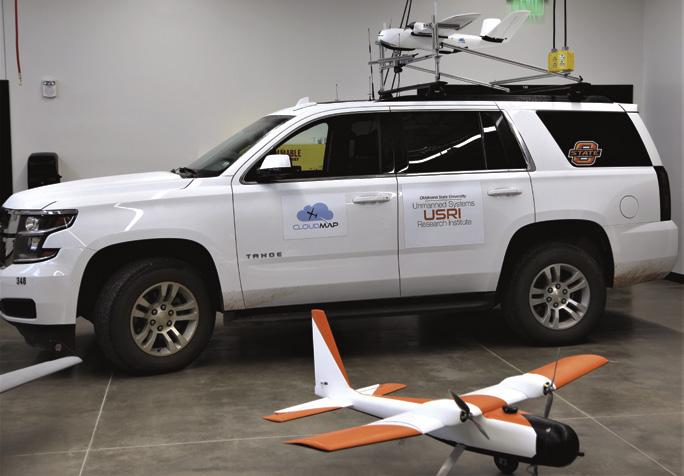
Muwanika Jdiobe is an undergraduate researcher and mechanical and aerospace engineering senior who works in the USRI lab on the development of unmanned systems for environmental observations. He is excited about the new opportunities gained from being able to operate in the new Unmanned Research Lab.
“This new lab gives me the opportunity to work in a world-class facility with cutting-edge tools and technology,” Jdiobe said. “This means our research and development of unmanned systems just moved to a whole new level than we had before. I am really excited about the future for USRI.”
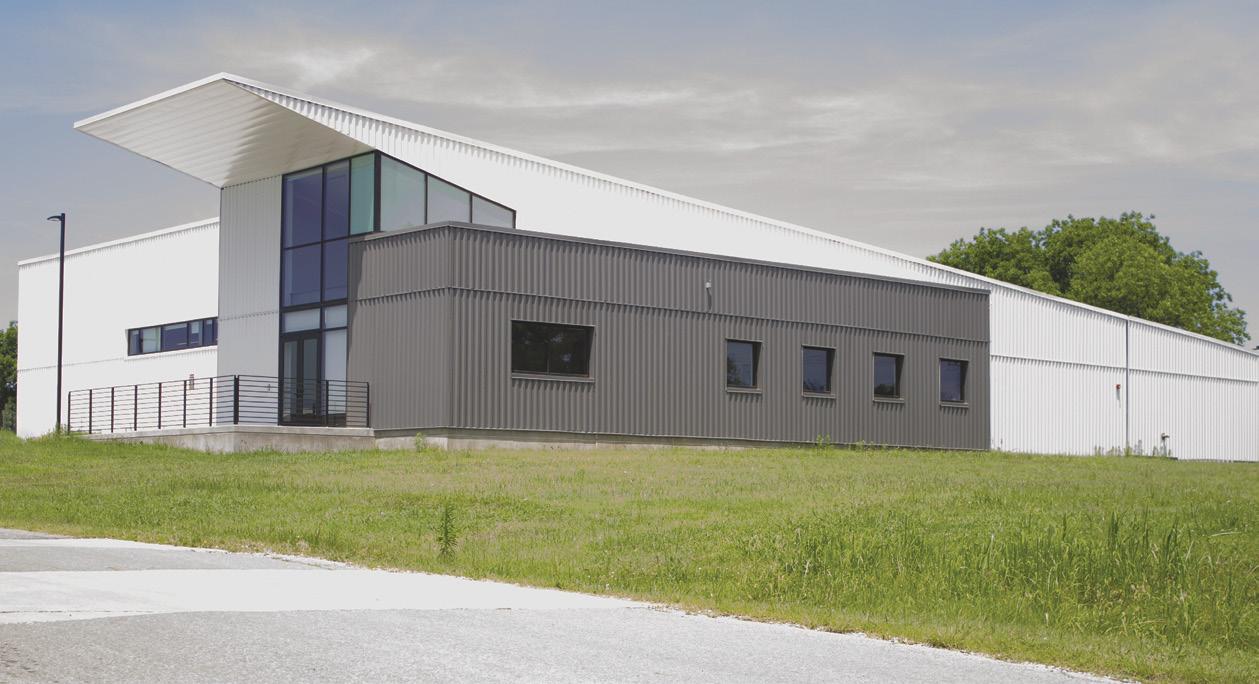 USRI’s mobile ground station and launch system were developed to assist in the deployment of unmanned aircraft for severe storm research, including capabilities to launch and control UAVs while en route to potential hazardous storms. This includes such aircraft as the jet powered Tornado Intercept Aircraft (TIA) and the Meteorological Analysis and Research Investigation Aircraft (MARIA), shown in the foreground.
The new home of the Unmanned Systems Research Institute
USRI’s mobile ground station and launch system were developed to assist in the deployment of unmanned aircraft for severe storm research, including capabilities to launch and control UAVs while en route to potential hazardous storms. This includes such aircraft as the jet powered Tornado Intercept Aircraft (TIA) and the Meteorological Analysis and Research Investigation Aircraft (MARIA), shown in the foreground.
The new home of the Unmanned Systems Research Institute
“The facility will act as a central hub and will contain all of the resources needed for all campus and industrial collaborators.”
OSU COLLEGE OF ENGINEERING, ARCHITECTURE AND TECHNOLOGY 53
— DR. JAMEY JACOB
Fixing Fences
Goedecke’s connection solution gets to market with help from the New Product Development Center
A2014 burn ban in Oklahoma can be credited for the invention that won Ron Goedecke, the Regent Business Partnership Award in March 2019.
The Okmulgee resident invented his Fence Bullet after he realized there were no metal bracing and pipe fencing connectors that didn’t require welding on the market.

“It was really just happenstance,” he said. “I bought my acreage and needed to put a fence in, but we were in a burn ban, so I was looking for a solution to the problem. The thing that got me is I could not find anything out there.”
As a result, he solved the problem himself. Goedecke used general fabrication skills he learned growing up on a dairy farm in northeastern Oklahoma to produce his first prototype.
After successfully testing the prototype on his own fence and a referral from the OSUIT technology engineering department at the Okmulgee campus, Goedecke applied to the Inventor’s Assistance Service through Oklahoma State University’s New Product Development Center.
Goedecke, who mostly operates his business single-handedly, said he is thankful for the patience and detailed work the NPDC provided him with. The engineering interns at the NPDC are highly qualified engineering students at OSU.
The NPDC gave a critical eye to the idea and produced market and patent research analysis for Goedecke. The NPDC also provided drawings of the product, which were used to apply for and receive a provisional patent.
“If you really want someone to look at your product, you need a drawing done in SolidWorks,” Goedecke explained. “It could be a wonderful idea, but if it is on a napkin, you just do not get the same credibility as if it is done in a drafting software.”
The Regent Business Partnership Award surprised and honored Goedecke.
“Sometimes the little guys do not get the spotlight,” he said. “You want to hear those stories about someone small. Not everyone is a big partner, sometimes it is the little partner.”
Goedecke said he made 15-20 design and function changes before he was satisfied with the product. The slow growth of the design allowed him to think through all the details.
“The inventive process starts at A,” he said. “But you do not know if it is going to be C, D or even Z before you really get to where you are happy with the product.”
54 IMPACT 2018 STORY ISABELLE BARRETT | PHOTOS COURTESY OF RON GOEDECKE
Fence Bullet built using no-weld double brace pipe connectors.
The next step of Goedecke’s journey led him to manufacturing the Fence Bullet. Bouncing ideas off different people at the NPDC, he realized there are many different ways to manufacture a product. The development process taught Goedecke costeffective manufacturing — and he decided to keep his manufacturing in-house.
“At first, I was having the tubes cut for me,” Goedecke said.” But now I have a machine to cut my own tubing. I have a lot more control over the process now that I have a shop, and I was able to further reduce my cost.”
Goedecke also faced the challenge of marketing a brand-new concept to an existing market. Many people have used welders to build pipe fence for decades while others used wood posts to avoid the cost of a welder. Goedecke stresses that his product saves money and time.

“The internet is great because I can put videos up on YouTube and on my website,” Goedecke explained. “People will understand what the product does, then word of mouth helps to spread the information.”
The Fence Bullet has been well received in states with rough terrain such as Wyoming, Idaho and Montana, he said. Many of his sales have been to large fencing contractors who like the idea of saving time and reducing the potential liability of fire. Goedecke has received orders from Hawaii and inquiries from Canada. The Fence Bullet is sold in 30 stores in 10 states. His widespread success did not happen overnight, though.
“It’s taken me a lot longer (than I expected) to get my product out there,” Goedecke said. “Everyone thinks things will go viral and ‘boom!’ in a year people will think it is the most wonderful thing. But it has not worked that way; it has been a slow-going process.”
Goedecke said he is grateful for the slow start, however. He said it has given him time to build inventory, figure out a packaging system that works and study the market.
Goedecke handles pretty much everything, including the day-to-day business operations. Currently, an intermittent part-time employee assists with batch manufacturing once a month. Aside from that, the work falls on Goedecke with assistance from his wife, Connie.
“When you are starting out as a one-manshow, you have to change hats,” Goedecke said. “I have had to put on my marketing hat, take it off, go to my manufacturing hat, then take it off to be an administrator, then take that hat off and go back to marketing. You do it all.”
OSU COLLEGE OF ENGINEERING, ARCHITECTURE AND TECHNOLOGY 55
The Fence Bullet invented by Ron Goedecke.
Expanding Scholarship Opportunities
Each year, Oklahoma State University and the College of Engineering, Architecture and Technology award millions of dollars in scholarships to outstanding students who are intellectual and organizational leaders.
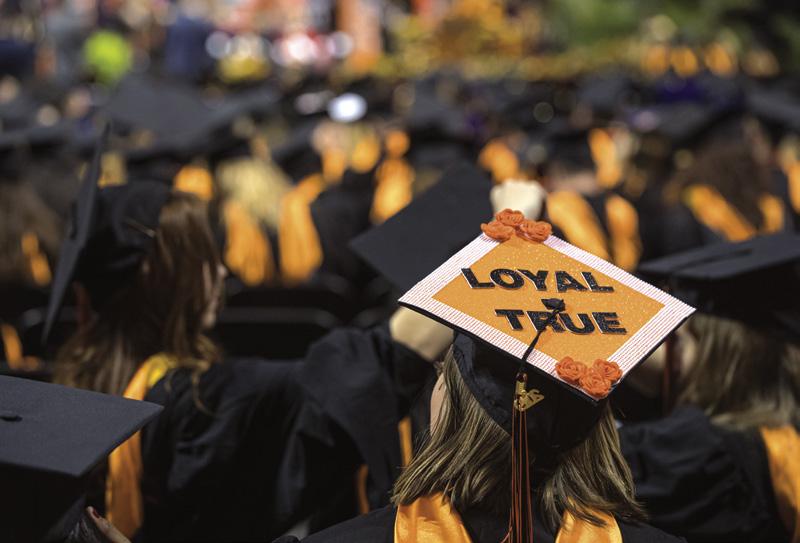
More than 1,300 CEAT students received scholarships from the college this year, and this number grows each year. “We have our generous donors to thank for our ability to recognize and award these unique students,” said Amanda Williams, CEAT manager of recruitment and scholarship programs. CEAT has helped over 4,000 students over the last seven years with gifts from Dolese Brothers Co. The Dolese gift provides financial support, academic tutoring support and programming
support. This keeps students engaged and contributes to what CEAT Dean Paul Tikalsky calls the “Dolese effect,” an increase in freshmen retention and an over 100 percent increase in the number of engineering graduates.
Natural gas energy company ONEOK provided the funding for 64 scholarships for CEAT students involved in diversity and inclusion organizations on campus as well as mentor support for 15 Parker — Engineering, Architecture and Technology Experts, a group of upperclassman CEAT students living in the Parker Living and Learning Community and serving as mentors for incoming freshmen. With this gift, CEAT provided an additional $200,000 in student support for the 2019-20 academic year.
Over the next few years, the college plans to expand the CEAT Scholars Program from 85 scholars in 2017 to a goal of 350 in 2022. For the 2019-20 academic year, CEAT will have 103 continuing scholars in the program and 90 new freshmen for a total of 193. The CEAT Scholars Program includes a package worth over $19,000, engages mentors, creates global awareness and develops leaders through a unique set of enrichment activities. Similar to the “Dolese effect,” the CEAT Scholars Program delivers higher retention and four-year graduation rates.
CEAT Scholar Skyler Jacob described the program: “It creates an engaged community of peers who are able to receive professional development and cultural education, which allows us to have a greater perception of the world and helps us to navigate the professional world with ease.”
STORY AMANDA WILLIAMS | PHOTO PHIL SHOCKLEY
56 IMPACT 2019
The CEAT Scholars Program includes a package worth over $19,000, engages mentors, creates global awareness and develops leaders through a unique set of enrichment activities.
Supporting CEAT
Private support continues to play an integral role in advancing the mission of OSU’s College of Engineering, Architecture and Technology. With ongoing budget cuts from the state legislature, we need private support now more than ever to help advance our mission.
State budget cuts to higher education are not a unique phenomenon across the country, so the opportunity exists for OSU CEAT to distinguish itself from other statesponsored engineering programs. If

our alumni and friends will fully engage in supporting our mission, we will continue our influence regionally and could advance our influence nationally.
Your support for the college’s mission can come in a variety of forms. Whether it be through your time volunteering, sharing your expertise or including CEAT as part of your charitable donations, your appropriately applied support can help significantly. We welcome the opportunity to hear from every one of our alumni and friends on how you can support the college.
In partnership with the OSU Foundation, the college has five team members with more than 40 years of experience in higher education dedicated to answering any questions you may have related to supporting the college. We know the greatest need of our students, professors and programs, and we can leverage your resources to the fullest potential.
As you consider making OSU CEAT a beneficiary of your support, please feel free to call or email a representative from our development team with any inquiries.
Tylerr Ropp
Senior Director of Development & Team Lead, CEAT
405-385-5664
tropp@osugiving.com
Jill Johnson
Senior Director of Development, CEAT
405-385-0733
jjohnson@osugiving.com
Bryce Killingsworth
Associate Director of Development, CEAT
405-385-5623
bkillingsworth@osugiving.com
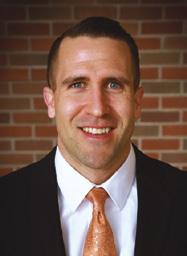 Jill Blake Development Associate
Jill Blake Development Associate
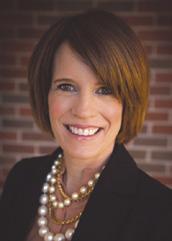
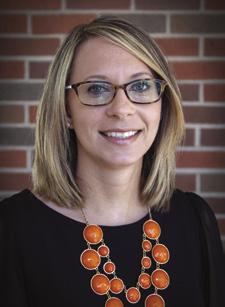
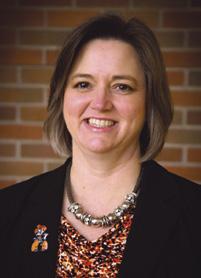
405-385-5156
jblake@osugiving.com
LaRonna Wilbourn
Senior Development Coordinator
405-385-5618
lwilbourn@osugiving.com
FROM THE FOUNDATION
OSU COLLEGE OF ENGINEERING, ARCHITECTURE AND TECHNOLOGY 57
COLLEGE OF ENGINEERING, ARCHITECTURE AND TECHOLOGY
2018 DONORS
$500,000+
National Instruments
Dolese Bros Co.
$100,000-$499,999
Wayne Allen, IEM ’69 & Judith Allen
Mark Brewer, ECEN ’88 & Beth Brewer
Devon Energy Corporation
ExxonMobil
Rickie Fowler
Fractionation Research Inc.
Jack Graham, ECEN ’59
Keysight Technologies Inc.
Phillips 66
Shimadzu Scientific Instruments Inc.
Waylink Systems Corporation
XTO Energy
$50,000-$99,999
Deborah Adams, CHE ’83 &
Charles Adams
Cecil Culver, CHE ’54
Kimberly-Clark Company
John Klopp, CHE ’65
Martin Family Foundation
Jaime McAlpine, ENGR TECH ’79 & Cheryl McAlpine
Billy Travis, MAE ’59 & Jane Travis
Sharon Voskuhl, MAE ’80 & Alan Staab
Webco Industries Inc.
Williams
Doyle Young
Darton & Jamie Zink
$25,000-$49,999
3M Company
AEP/Public Service Company of Oklahoma/Tulsa
AISC Education Foundation
Charles Albanese
Avery Dennison Corporation
John Brown, CIVE ’68 & Judy Brown
Brueckner Group USA Inc.
Kenneth Case, IEM ’69 & Frances Case
Chevron Phillips Chemical Company LP
ConocoPhillips
Michael Damore, ARCH ’73 & Sharon Damore
Andrew Deck, CHE ’84 & Becky Deck
EI DuPont de Nemours & Company
Kelly Harris, CIVE ’04 & Carey Harris
Myron Hayden, CIVE ’78 & Judith Hayden
William Johnson, ENGR TECH ’76 & Barbara Johnson
Charlie King, CIVE ’50
Robert Milam, CIVE ’84 & Ramona Milam
Jim Penn, CIVE ’79
Jeffrey Powers, IEM ’76 & Sheryl Powers
Arthur Rigg, ECEN ’49
Neil Ryan, ENGR TECH ’80 & Katherine Ryan
Gene Smith
Kevin Stephney, ECEN ’79 & Tangye Stephney
Terry Stewart, CHE ’72 & Karen Stewart
Bradley Stover, CHE ’84 & Trina Stover
UPM Raflatac
$10,000-$24,999
American Concrete Pumping Association
Ken Barrett, MAE ’65 & Maureen Barrett
Caleb Bates, ENGR TECH ’07 & Whitney Bates
Bobby Blair, CHE ’64
Larry Blake, CHE ’71 & Kathy Cowan
Boeing Company
Paul Caldwell, MAE ’70 & Mabel Caldwell
Mark Dickerson, CHE ’76 & Lee Ann Dickerson
Scott Edwards, MAE ’88 & LouAnn Edwards
Delores Etter & Jerry Etter, MAE ’67
Halliburton Foundation Inc.
Kerry Havner, CIVE ’59
Steven Hofener, CIVE ’75 & Sherryl Hofener
Johnson & Johnson
Phillis June
Randy Kreie, ARCH ’78 & Valda Kreie
Laurette Lahey, MAE ’86 & Timothy Lahey
John Lawrence, CHE ’82 & Carolyn Lawrence
Neal McCaleb, CIVE ’57 & Georgann McCaleb
Katherine McCollom
Toni Melton
Mitchell Myers, IEM ’95 & Christy Myers
National Fire Protection Association
NorthStar Battery Company
Chad O’Connor, CHE ’11
OG&E Energy Corp.
Raymond Pappe, MAE ’58 & Shirley Pappe
Karen Plummer & Joe Plummer, CHE ’66
Mervin Snowden, ARCH ’66 & Naomi Snowden
Rick Tompkins, CIVE ’78 & Lisa Tompkins
UtopiaCompression Corporation
Alyssa Warner, CHE ’02 & Jeffrey Warner
Steven Wear, ECEN ’85 & Judy Wear
Richard Webb, IEM ’84 & Sandra Webb
Gordon White, CHE ’63 & Carol White
Ronald Wickens, MAE ’57 & Julia Wickens
Jim Williams, MAE ’80 & Lynne Williams
Gary Wilson, CHE ’89 & Kerri Wilson
Brent Wooten, CIVE ’74 & Mary Wooten
$5,000-$9,999
Kevin Bailey, ENGR TECH ’95 & Desiree Bailey
Danny Blakely, ENGR TECH ’82 & Melanie Blakely
Bluewater Technology
Board of Certified Safety
Professionals
Bosch Thermotechnology Corp.
Thomas Britton, IEM ’68 & Deborah Britton
Mallory Buckley, ARCH ’17 & Dyne Buckley, MAE ’17
Kirk Courson & Krista Courson
Crossland Construction Company Inc.
Deborah Dawson
Dekko Foundation Inc.
Erica Dekko, IEM ’92 & Tim Kochanski
Jo Ann DeVries
Suleiman Diab, CHE ’83
Mike Dossey, CHE ’65 & Anita Dossey
Egg Geo LLC
Enviro Systems Inc.
Jacque Fowler
John Glenn, ARCH ’96 & Briar Glenn, ARCH ’02
Jack Goertz, IEM ’74 & Susan Goertz
Chad Grinsteiner, CIVE ’97 & Michelle Grinsteiner
Daniel Grischkowsky
John Groh, MAE ’60 & Nancy Groh
Glen Hicks, MAE ’68 & Diane Hicks
Koch Industries Inc.
Donald Lehman, CHE ’69 & Laura Lehman
Jeffrey Linihan & Louise Linihan
Megan Lipscomb, CHE ’08 & Joseph Lipscomb
Jamie Matlock, IEM ’03 & James Matlock
Mervin Bovaird Foundation
Amy Niemann, CHE ’90 & Joseph Niemann
ONEOK Foundation
Bill Phelps, MAE ’60 & Susie Phelps
Brian Price, CHE ’73 & Brenda Price
Ashley Price, CHE ’04
Thomas Ratzki, CIVE ’79 & Amy Ratzki
Dale Shellhorn
Cheryl & Bart Snyder
Society of American Military
Engineers/OKC Post
Edward Stokes, CIVE ’75 & Claudia Stokes
Al Strecker, ECEN ’71
Tall Oak Midstream LLC
Paul & Julie Tikalsky
W&W AFCO Steel
J.D. Waggoner, MAE ’57
WaterFurnace International Inc.
Sandra Yeigh, IEM ’88 & Bjong Yeigh
$1,000-$4,999
ABB Inc.
Acme Brick Company/Fort Worth
ACP Sheet Metal Company
Gregory Adams, ENGR TECH ’80 & Leah Adams
Adolfson & Peterson Construction
Mark Aebi, ENGR TECH ’84 & Tori Aebi
AGCO Corporation
AIA Oklahoma
Allen Contracting Inc.
Gary Allen, ENGR TECH ’82 & Judy Allen
Arvind Amin, MAE ’75 & Hema Amin
Anadarko Petroleum Corporation
Andres Construction Services LLC
APAC Central Inc.
Gilbert Asher, ECEN ’66 & Jane Asher
Association of Oklahoma General Contractors Inc.
Robert Atkinson, ECEN ’08
Austin Commercial LP
Austin Lee LLC
B+T Group Holdings Inc.
Matthew Balven, CIVE ’04 & Rachel Balven
Bartlett Cocke General Contractors LLC
David Bardwell & Sherrlyn Bardwell
Alec Barker, MAE ’17
Courtney Baugher, IEM ’88 & Bruce Baugher, CHE ’88
Otto Behunin, IEM ’64 & Kathryn Behunin
Kenneth Bell & Karen Bell
Carolyn Bell
Frank Berry, ENGR TECH ’62 & Diana Berry
William Biscontini, ENGR TECH ’67
Robert Bogan, MAE ’99
Boldt Company
Edward Bond & Lauren Bond
Johnnie Boyle, MAE ’72
Wallace Brasuell, ECEN ’62 & Flora Brasuell
Arthur Breipohl & Shirley Breipohl
Pat Brock, IEM ’83 & Barbara Brock
Kristi Bumpas, CIVE ’12
Burns & McDonnell Foundation
Richard Bush, IEM ’63
Byrne Construction Services
Caminos Fire LLC
Cantera Concrete Company
Centennial Contractors Enterprises Inc.
Central OK Section Illuminating Engineering Society
John Chau, ARCH ’89
Choctaw Nation of Oklahoma
Choctaw Nation Health Services
Kalli Clark-Egan, ETM ’08 & Sean Egan
ClimateMaster Inc.
Clifford Clottey, CIVE ’77
Brad Clowe, ECEN ’94 & Ronnie Clowe
Steven Constien, ECEN ’02
Kenneth Cooper, MAE ’76 & Janell Cooper
Teresa Cooper
Cowan Group Engineering LLC
Beverly Cowan & Jeff Cowan
Jimmy Cox, MAE ’63
CP&Y Inc.
Cary DeHart, ENGR TECH ’74 & Bobbie DeHart
Weston DeHart, ENGR TECH ’06 & Julie DeHart
Christopher DeMoss, ENGR TECH ’02 & Erin DeMoss
Megan Dickey, IEM ’09
Blaine Douglas, ENGR TECH ’93 & Kellie Douglas
Ray Earley, ECEN ’81 & Sharon Earley
Laura Easley, IEM ’87 & Jeff Easley
Donald Ebbs, MAE ’57
Austin Edgar, ENGR TECH ’13
EME Consultant LLC
Brian Engelman, MAE ’02 & Alexia Engelman
William Engstrom & Julie Engstrom
Enterprise Products Partners LP
David Eudey, MAE ’04 & Laura Eudey
Susan Evans & Robert Evans
Faith Technologies Inc.
Wuyi Fang
Gerard Fehrenbach & Ming Fehrenbach
Firetrol Protection Systems Inc.
Flintco LLC
J. Stephen Ford, ARCH ’70 & Jane Ford
Linda Foster
Sanda Fry & Darrel Fry, MAE ’67
Garney Holding Company
Garver LLC
Kenneth Gauntt, MAE ’58 & Peggy Gauntt
GE Johnson Construction Co.
General Electric Corp.
Georgia-Pacific Financial Management LLC
Barney Ghiglieri, CHE ’72
Michael Gilbert, CHE ’78 & Verna Gilbert
Hulbert Glimp, ECEN ’66 & Carolyn Glimp
Fernando Gonzalez
Richard Gray, ECEN ’61 & Rosemary Gray
Guy Engineering Services Inc.
Tamara Haas, CIVE ’83 & Anthony Haas
Denise Hale, CIVE ’95 & Allan Hale
Joe Hall, CIVE ’83 & Vickie Hall
James Halligan & Ann Halligan
Syed Hamid, MAE ’76 & Zeba Hamid
John Harder, MAE ’67 & Mildred Harder
Michael Harris, MAE ’66 & Patricia Harris
Roger Harrod, ENGR TECH ’93
John Hatheway, MAE ’53 & Betty Hatheway
Charles Heller, CIVE ’60 & Susan Heller
David Heller, ENGR TECH ’81 & Paula Heller
Lee Henderson, MAE ’82 & Marta Henderson, IEM ’83
John Hendricks, MAE ’75 & Teresa Hendricks
William Henry, ECEN ’80 & Cindy Schultz
Jack Hensley, ENGR TECH ’72
Nancy Herrin
David Hieronymus, CHE ’77
Kimberly Hodges & Robert Hodges
Judy Holderread & Jerry Holderread, ENGR TECH ’66
Home Builders Association of Greater Tulsa
Don Hubbard, CHE ’67 & Rita Hubbard
Chris Humes, MAE ’90 & Dianne Humes
Dennis Hussey, CHE ’00
IBM Corporation
Interstates Construction Services Inc.
Steven Irby, CEAT ’72 & Rebecca Irby
JE Dunn Construction Co.
Johnson Controls Foundation
Lucien Jones & Barbara Jones
James Jones, MAE ’87
Min Kang, CHE ’14
Mark Kelley, MAE ’87 & Sharon Kelley
Rodney Kelly, ENGR TECH ’83 & Mandy Kelly
Robert Kersten, CIVE ’56
Larry Kester, ARCH ’68 & Linda Kester
Jordan Kidd, CHE ’07 & Kristeen Kidd
Kiewit Corporation
Christina Kuhlmann, CIVE ’05
Michael Larranaga, ENGR TECH ’96 & Patricia Larranaga
John Larson, ECEN ’78 & Sharon Larson
Samir Lawrence, CIVE ’63 & Lucille Lawrence
David Lee, ECEN ’95 & Amanda Lee
Karyl Lee
Stan Lingo, ARCH ’89 & Renee Lingo
Lithko Contracting Inc.
Duoying Liu, ECEN ’88 & Yuan Yue Liu
John Lloyd & Ruth Lloyd
Lockheed Martin
Jill Long, CHE ’03
Richard Lowery, MAE ’57 & Anne Lowery
Shane Lupi, ENGR TECH ’14
Mark Marston, CHE ’75
Billy Martin, ENGR TECH ’83 & Janan Martin
Duane Mass, ARCH ’89 & Robin Mass
Matrix Service Company
McCarthy Building Companies Inc.
McCarthy Holdings Inc.
Susan McKenzie, MAE ’80
Steve McKnight & Kimberly McKnight
Robert Merkle, ECEN ’77 & Susan Merkle
Albert Meyer, ECEN ’49
William Miller, CHE ’99 & Jessica Miller
Bill Minnett & Karna Minnett
Kevin Moore, CIVE ’02
Bradley Muslow, CHE ’01 & Erika Mulsow
Muncrief Family Foundation
Richard Muncrief, ENGR TECH ’80 & Gail Muncrief
Nabholz Construction Corporation
Raphael Nguyen, ENGR TECH ’96 & Thuy-Trang Nguyen
North American Society for Trenchless Technology
Kevin O’Brien, MAE ’77 & Judith O’Brien
Steven O’Hara, ARCH ’85 & Phyllis O’Hara
OK Municipal Power Authority
OK Structural Engineers Association
OKC Community Foundation
Oklahoma State Firefighters Association
Oklahoma Section of the American Society of Civil Engineers
Okland Construction Company Inc.
Olsson Associates Inc.
Steven Oltmanns, ECEN ’71 & Billie Oltmanns
ONE Gas Inc.
Ronald Orr, IEM ’79 & Diana Orr
Emma Orth, CHE ’16
Katie O’Shea, IEM ’10
Mark Paden, CHE ’97 & Shayna Paden
Phu Phan, ECEN ’99 & Gayla Phan
Jenna Pisarski, CHE ’16
Plastics Pipe Institute
Paul Poynter, CIVE ’95
Donald Pruitt, MAE ’62 & Mary Pruitt
Lee Raney, IEM ’52 & Grace Raney
Raytheon Company
Michael Reifel, CIVE ’70
Rick Scott Construction Inc.
John Richardson, CIVE ’61 & Jean Richardson
Ronald Rivers, IEM ’64
RJN Foundation
Eston Rogers, ENGR TECH ’08
Laurence Rooney & Kathleen Rooney
Michael Royce, MAE ’88 & Stephanie Royce, IEM ’88
Jerry Ryan, IEM ’64 & Robin Ryan
Eric Schiess
Jason Semien, ECEN ’14
SG Administration LP
Sherwood Construction Company Inc.
Robert Sherman & Diane Sherman
J. Michael Short
Brenda Shumate, IEM ’91 & Casey Shumate
Kathleen Smith, IEM ’93 & Rodney Smith
Elbert Sneed, ECEN ’79 & Kathryn Sneed
Jack Snoddy, ECEN ’63 & Barbara Snoddy
James Snyder, CHE ’72
Southern Company Services Inc.
Southland Holdings
Brian Storts, CHE ’99 & Ruth Storts
Studs Unlimited LLC
Jeffrey Szcinski, ECEN ’14
Lyndon Taylor, IEM ’81 & Pamela Taylor
Teaching Mastery Institute Inc.
Joseph Testa, ENGR TECH ’88 & Karen Testa
TEXO Education and Research Foundation
Sally Thomas, CHE ’79
Robert Thompson, CIVE ’65 & Lynda Thompson
Mark Thompson, ARCH ’84
David Timberlake, ARCH ’65 & Sarah Timberlake
Tompkins Resources Inc.
Marcia Tuttle
John Tye, IEM ’68
University of Tulsa
Valero Services Inc.
Larry Vorba, CIVE ’89 & Linda Vorba
Stephen Waken, ECEN ’80
Walsh Group
Walters Morgan Construction
Van Weathers, GEN ENG ’65
Patricia Weigand
White Engineering Associates Inc.
Sherry White & Ronald White, CIVE ’63
David Wiist, CHE ’07 & Lindsey Hall-Wiist, CHE ’07
Michael Wilcox, ECEN ’89 & Mary Wilcox
Charles Williams, MAE ’78 & Lorene Williams
Charles Williams, ECEN ’81 & Yvonne Williams
George Winters, ARCH ’83 & Laura Winters
Nathaniel Woody, MAE ’13
Keith Yancey, ARCH ’84 & Katherine Yancey, ARCH ’85
Younger-Holmes Electrical Contractors Inc.
Bobby Blair, CHE ’64
Frederick Chadsey, ARCH ’60
Gary Flesher, ARCH ’80
Stanley Henson
Phillip McCurdy, ARCH ’68 & Linda McCurdy
Carl Robertson, CHE ’88
Christopher Stewart, ECEN ’72
Rick Webb, IEM ’84 & Sandra Webb
Thank you to all of our generous donors! Planned Giving Donors who included CEAT with their estate plans in 2018
THANK YOU TO OUR DONORS!


At Oklahoma State University, student success would not be possible without the generous donations of friends and alumni of the College of Engineering, Architecture and Technology.
The gifts given for scholarships, facilities, faculty support, research endeavors and all other program needs provide OSU students with a premier education. We are thankful to each and every donor who aids in creating an unmatched education for our students.

This map reflects each location for our donors who gave $1,000 or more to the College of Engineering, Architecture and Technology in 2018. A larger represents multiple donors in that location.
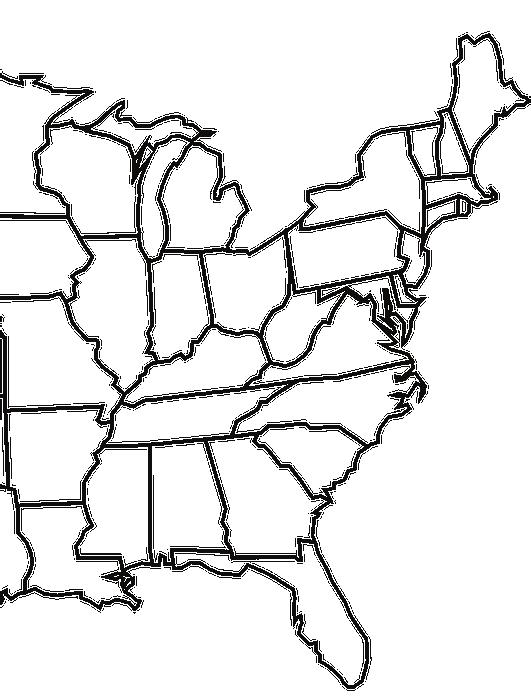
The Strategic Advisory Council is a strategic group of industry leaders and alumni representing each discipline in CEAT. Each member volunteers to work with the dean to provide a better college experience for all our students. They are dedicated to improving our research, retention and reputation by bringing innovation and industry into our classrooms.

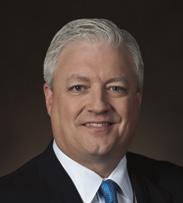
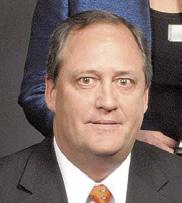
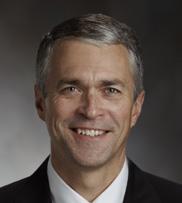
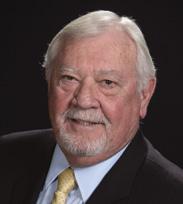
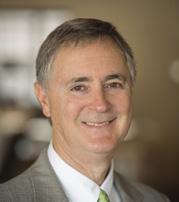
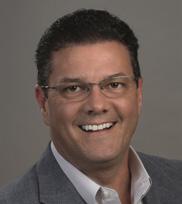
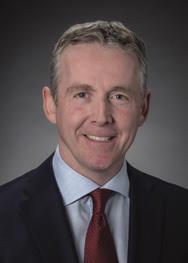

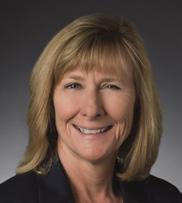
STRATEGIC ADVISORY COUNCIL 62 IMPACT 2018
Debbie Adams Retired Senior Vice President of HSE, Projects & Procurement Phillips 66
Gregg Bradshaw
Joe D. Hall Certified Professional Constructor General Contractors LLC
Shay Braun Chief Supply Chain Officer Treehouse Foods
Jim Hassenbeck Principal Architect Studio Architecture
John Doerner Vice President XTO Energy
Heath DePriest Managing Director, BD-Terminals Phillips 66
Larry Bryce COO Construction CNH Industrial
Garen Ewbank President Ewbank Geo Testing
Mike Carolina Executive Director OCAST
Jeff Fisher CEO Ascent Resources
Paul


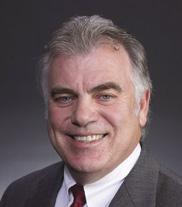
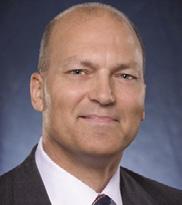
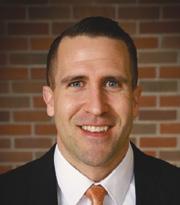
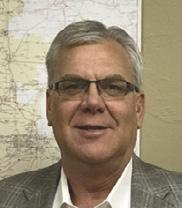


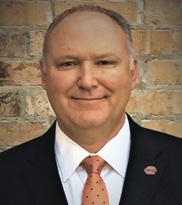
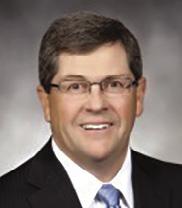
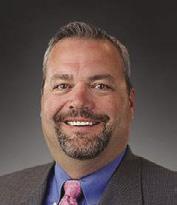
OSU COLLEGE OF ENGINEERING, ARCHITECTURE AND TECHNOLOGY 63
Steve Huckaby Chairman and CEO Meritage Midstream
Jeff Hume Vice Chairmain, Strategic Growth Initiatives Continental Resources Inc.
Bob Milam CEO Eagle Claw Midstream
Mitch Johnson President AI Technologies
Neal Jones President Jones Studio Architects
Jaime McAlpine President Chermac Energy Corp.
Rick Webb CEO Webb Consulting Group
Ty Ropp Senior Director of Development OSUF
Ed Stokes President Stokes International Consultancy LLC
Bill Remy President & COO TBM Consulting Group
Tikalsky CEAT Dean Oklahoma State University
HALL OF FAME AND LOHMANN AWARDS Hall of Fame and Lohmann Hall of Fame
Brian Price Edward Shreve Ali Fazel
Brian Price grew up in Duncan, Oklahoma, and attended OSU’s College of Engineering, Architecture and Technology, where he received his bachelor’s and master’s degrees in chemical engineering.
Price began his industrial career with ARCO Oil & Gas, working his way up in process and gas plant engineering to become manager of process engineering and manager of projects. During his time at ARCO, Price was responsible for the design and operation of a pilot plant to develop a new carbon dioxide separation technique using cryogenic fractionation, which was subsequently applied in numerous installations. He was also involved in the design of many cryogenic facilities such as the first nitrogen rejection unit project designed to handle variable composition gas, one of the largest separation units for N2 injection, and numerous natural gas liquids (NGL) recovery units. After moving to manager of projects, Price was involved in onshore and offshore oil and gas development. His projects included the installation of a cryogenic NGL recovering unit on an offshore platform and the first tripod drilling and production platform in water more than 50 feet deep.
Price joined Black & Veatch in 1991 as technology manager for gas processing and NGL recovery and later became liquid natural gas (LNG) technology manager. He developed and patented PRICO® LNG production technology for Black & Veatch, which became the basis of a business unit focused in this area. While vice president of LNG, he oversaw the development of more than 30 LNG plants using the patented technology. These plants included 21 plants in China, which can produce over 9 million gallons per day of clean LNG fuel for vehicles and industry applications. The most recent new application of the PRICO® technology is for floating liquefied natural gas (FLNG). Two recent projects included the world’s first LNG production barge and the first successful project to add LNG production onto an existing LNG tanker. These projects are the first of dozens of FLNG systems.
Price has 43 years of industry experience, has worked on more than 40 NGL and LNG projects, is a holder of five U.S. patents and five international patents and has authored 65 technical papers. He has served on the editorial review board of the Gas Processors Association for the past 30 years and as the chair member of the editorial review board for the past 20 years. He serves as editor of three sections of the Gas Processors Suppliers Association Engineering Data Book, volunteering his time and efforts to ensure that engineers have the most up-to-date and accurate information about the measurement, storage and refrigeration, and processing of gases.
For his work, Price has received numerous awards including the Lifetime Achievement Award from the Gas Processors Association in 2016. The Lifetime Achievement Award recognizes individuals whose exceptional career efforts and achievements have provided lasting benefits to the Gas Processors Association Midstream and the midstream industry.

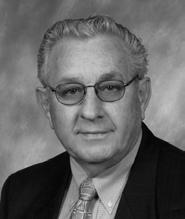
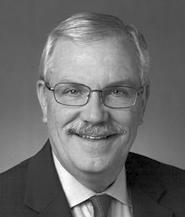
Edward Shreve was born and raised in Oklahoma City. Shreve joined the United States Navy in 1953, serving as an electronics technician. While in the Navy, he found that he had a strong interest and aptitude for electronics. This led to his decision to pursue a degree in electrical engineering.
After his military service, Shreve earned his bachelor’s degree from the University of Oklahoma and his master’s degree from New Mexico State University. Shreve decided to return to his home state to pursue his doctorate in electrical engineering from Oklahoma State University. After graduation, he accepted a senior engineering position for Control Data Corporation in Bloomington, Minnesota. Soon realizing how much he truly loved Oklahoma, Shreve decided to return home where he accepted a faculty position at OSU as an associate professor in the College of Engineering, Architecture and Technology.
During his tenure as a professor, Shreve noticed that a large number of engineering graduates would leave Oklahoma for employment opportunities in other states. This inspired him to create a model for a Stillwaterbased engineering business that would provide OSU engineering graduates opportunities for challenging and rewarding careers in Oklahoma. Working with his friend and colleague Lloyd Salsman and his wife, Peggy Shreve, he co-founded Frontier Engineering Inc. in October 1973.
Known today as Frontier Electronics Systems Corporation, the company is a thriving engineering business that designs and manufactures world-class electronic products for the aerospace and defense industries.

Shreve served on various OSU industry advisory boards, including serving as the chairman of OSU’s Laser Development and Applications Center Advisory Board. He served three-plus Oklahoma governor-appointed terms on the Oklahoma Science, Technology, Research and Development Board, which is the governing board for the Oklahoma Center for the Advancement of Science and Technology. He authored nine comprehensive technical publications and directly contributed to the development of four patents. Working with OSU, Stillwater city government and CareerTech as a member of the Oklahoma Technology and Research Park board of directors, Shreve was directly involved in developing a research park where collaboration between industry and university researchers is the basis of the park’s identity.
Ali Fazel grew up in Tehran, Iran, and earned his bachelor’s degree in biological science and geology from Arak College of Science in 1974. After receiving his bachelor’s degree, Fazel moved to the United States and earned his master’s degree in environmental engineering from the University of Oklahoma and his doctorate in environmental engineering from Oklahoma State University.
Fazel established Accurate Inc. Environmental and Laboratory Services in December 1990 in Stillwater, Oklahoma, as a water and wastewater process consulting company that contained a small lab. Soon, Accurate Inc. became the largest nationally certified environmental laboratory in the region and three Oklahoma locations were established in Stillwater, Oklahoma City and Tulsa. In the fall of 1998, Fazel added a training division to his company called Accurate Training Center, which serves as a hands-on training school for water and wastewater operators in Oklahoma, Kansas and Arkansas. Accurate Training Center has locations in Stillwater and Tulsa and provides training to nearly 600 water and wastewater operators per year and employs 60 individuals.
Accurate Inc. is made up of five divisions that include lab work, engineering, training, field services and laboratory supply sales and service. One of the unique programs offered by Accurate through its laboratory supply sales and service division is called Environmental Insurance, which is offered to municipalities as a retainer-based service to use for their environmental needs, laboratory requirements, water and wastewater systems troubleshooting, chemical needs, sampling requirements or for any regulatory requirements.
As president and director of Accurate, Fazel uses his experience in environmental chemistry, analytical methodology and quality control in conducting and supervising water, wastewater and hazardous waste analytical testing procedures. He has helped develop analytical testing programs that have involved the testing procedures and methodologies for analysis and evaluation of priority pollutants, extraction procedure toxicity, effluent toxicity and national pollutant discharge elimination system monitoring.
With his leadership, Accurate has received many awards, including the Oklahoma Venture Forum and Private Enterprise Award in 1993 for Outstanding Contribution to Oklahoma’s Economic Growth, Productivity and Innovation and an award for Outstanding Service to the State of Oklahoma in 2003 from the Department of Environmental Quality Laboratory Services Council.
2018
COLLEGE OF ENGINEERING, ARCHITECTURE AND TECHNOLOGY
COLLEGE OF ENGINEERING, ARCHITECTURE AND TECHNOLOGY

HALLOFFame
HALLOFFame
1954 Laurence L. Dresser
1954 Laurence L. Dresser
1955 Gerald W. McCullough
1955 Gerald W. McCullough
1956 Richard K. Lane
1956 Richard K. Lane
1957 Thomas M. Lumly Jr.
1957 Thomas M. Lumly Jr.
1958 Guy H. James
1958 Guy H. James
1959 Francis J. Wilson
1959 Francis J. Wilson
1960 Morrison B. Cunningham
1960 Morrison B. Cunningham
1961 Lloyd E. Elkins
1961 Lloyd E. Elkins
1962 Don McBride
1962 Don McBride
1963 B. Harris Bateman
1963 B. Harris Bateman
1964 William W. Caudill
1964 William W. Caudill
1965 Myron A. Wright
1965 Myron A. Wright
1966 Edwin G. Malzahn
1966 Edwin G. Malzahn
1967 Eugene L. Miller
1967 Eugene L. Miller
1968 David G. Murray
1968 David G. Murray
1969 Melvin A. Ellsworth
1969 Melvin A. Ellsworth
1970 Veldo H. Brewer
1970 Veldo H. Brewer
1971 Ralph M. Ball
1971 Ralph M. Ball
1972 Richard O. Newman
1972 Richard O. Newman
1973 David B. Benham
1973 David B. Benham
1974 Carl G. Herrington
1974 Carl G. Herrington
1975 James J. Kelly
1975 James J. Kelly
1975 Gus L. Maciula
1975 Gus L. Maciula
1976 Donald E. Adams
1976 Donald E. Adams
1976 James C. Phelps
1976 James C. Phelps
1976 Fred H. Ramseur Jr.
1976 Fred H. Ramseur Jr.
1977 John S. Zink
1977 John S. Zink
1978 Sidney E. Scisson
1978 Sidney E. Scisson
1979 John L. Hatheway
1979 John L. Hatheway
1979 Eason H. Leonard
1979 Eason H. Leonard
1979 Nicholas B. Mavris
1979 Nicholas B. Mavris
1980 John B. Jones Jr.
1980 John B. Jones Jr.
1981 William J. Collins Jr.
1981 William J. Collins Jr.
1982 Floyd M. Bartlett
1982 Floyd M. Bartlett
1982 Holmes H. McClure
1982 Holmes H. McClure
1983 Bill N. Lacy
1983 Bill N. Lacy
1983 George H. Lawrence
1983 George H. Lawrence
1984 Edward C. Joullian III
1984 Edward C. Joullian III
1984 Glenn E. Penisten
1984 Glenn E. Penisten
1985 Frank A. McPherson
1985 Frank A. McPherson
1986 James E. Barnes
1986 James E. Barnes
1986 Martin E. Fate Jr.
1986 Martin E. Fate Jr.
1987 Raymond A. Porter
1987 Raymond A. Porter
1987 James D. Cobb
1987 James D. Cobb
1988 Choong-Shik Cho
1988 Choong-Shik Cho
1988 Robert M. Penn
1988 Robert M. Penn
1989 Wilfred P. Schmoe
1989 Wilfred P. Schmoe
1989 Neal A. McCaleb
1989 Neal A. McCaleb
1991 Jim E. Shamas
1991 Jim E. Shamas
1991 J. Tinsley Oden
1991 J. Tinsley Oden
1991 David J. Tippeconnic
1991 David J. Tippeconnic
1992 W. Wayne Allen
1992 W. Wayne Allen
1992 Robert M. Lawrence
1992 Robert M. Lawrence
1992 Wolter J. Fabrycky
1992 Wolter J. Fabrycky
1993 Jack P. Holman
1993 Jack P. Holman
1993 Keith E. Bailey
1993 Keith E. Bailey
1993 Kenneth J. Richards
1993 Kenneth J. Richards
1994 Kerry S. Havner
1994 Kerry S. Havner
1994 Donald R. Lehman
1994 Donald R. Lehman
1995 Ted E. Davis
1995 Ted E. Davis
1995 D. Ray Booker
1995 D. Ray Booker
1995 Charles L. Hardt
1995 Charles L. Hardt
1996 R. Gerald Bennett
1996 R. Gerald Bennett
1996 Marvin M. Johnson
1996 Marvin M. Johnson
1996 Jerry D. Homes
1996 Jerry D. Homes
1997 H. E. Cobb Jr.
1997 H. E. Cobb Jr.
1997 J. N. Reddy
1997 J. N. Reddy
1997 Donald L. Wickens
1997 Donald L. Wickens
1998 Ronald D. Wickens
1998 Ronald D. Wickens
1998 John E. Hershey
1998 John E. Hershey
1999 Ronald L. Calsing
1999 Ronald L. Calsing



1999 John C. Mihm
1999 John C. Mihm
1999 Heinz W. Schmitt
1999 Heinz W. Schmitt
2000 Jim W. Bruza
2000 Jim W. Bruza
2000 Sherman E. Smith
2000 Sherman E. Smith
2000 Thomas W. Wallace
2000 Thomas W. Wallace
2000 Charles O. Heller
2000 Charles O. Heller
2001 B. N. Murali
2001 B. N. Murali
2001 Duane Wilson
2001 Duane Wilson
2001 Robert Braswell
2001 Robert Braswell
2002 Donald W. Vanlandingham
2002 Donald W. Vanlandingham
2002 Frank W. Chitwood
2002 Frank W. Chitwood
2002 H. Edward Roberts
2002 H. Edward Roberts
2003 Jim B. Surjaatmadja
2003 Jim B. Surjaatmadja
2003 James R. Holland Jr.
2003 James R. Holland Jr.
2003 Kent E. Patterson
2003 Kent E. Patterson
2004 J. D. “Denny” Carreker Jr.
2004 J. D. “Denny” Carreker Jr.
2004 Steven D. Hofener
2004 Steven D. Hofener
2004 David Kyle
2004 David Kyle
2004 Eddie M. Jones
2004 Eddie M. Jones
2004 Neal E. Jones
2004 Neal E. Jones
2005 James Brooks Cummins
2005 James Brooks Cummins
2005 Gordon E. Eubanks Jr.
2005 Gordon E. Eubanks Jr.
2005 Behrokh Khoshnevis
2005 Behrokh Khoshnevis
2006 Sanjiv Sidhu
2006 Sanjiv Sidhu
2006 James L. Vining
2006 James L. Vining
2006 Jack B. ReVelle
2006 Jack B. ReVelle
2006 Gary A. Pope
2006 Gary A. Pope
2007 Rand Elliott
2007 Rand Elliott
2007 Michael Damore
2007 Michael Damore
2007 Leslie Priebe
2007 Leslie Priebe
2008 Ronald L. Hoffman
2008 Ronald L. Hoffman
2008 Donald D. Humphreys
2008 Donald D. Humphreys
2008 Samir A. Lawrence
2008 Samir A. Lawrence
2008 Ronnie Morgan
2008 Ronnie Morgan
2009 Charles Kridler
2009 Charles Kridler
2009 Meemong Lee
2009 Meemong Lee
2009 A. Joe Mitchell Jr.
2009 A. Joe Mitchell Jr.
2009 Sridhar Mitta
2009 Sridhar Mitta
2009 Richard Weidner
2009 Richard Weidner
2010 Ray O. Johnson
2010 Ray O. Johnson
2010 Jerry Banks
2010 Jerry Banks
2010 Juan Carlos Calderon
2010 Juan Carlos Calderon
2011 Jeffrey Fisher
2011 Jeffrey Fisher
2011 Lakshmaiah Ponnala
2011 Lakshmaiah Ponnala
2011 Enos Stover
2011 Enos Stover
2011 Paul Liao
2011 Paul Liao
2012 Wilson Shoffner
2012 Wilson Shoffner
2012 Calvin Vogt
2012 Calvin Vogt
2012 Jerry Winchester
2012 Jerry Winchester
2012 Cassie Mitchell
2012 Cassie Mitchell
2013 Kenneth E. Case
2013 Kenneth E. Case
2013 Harvey B. Manbeck
2013 Harvey B. Manbeck
2013 Rixio Medina
2013 Rixio Medina
2013 Robert Schaefer
2013 Robert Schaefer
2013 Rick Webb
2013 Rick Webb
2014 Debbie Adams
2014 Debbie Adams
2014 Alan Brunacini
2014 Alan Brunacini
2014 Harold Courson
2014 Harold Courson
2014 Decker Dawson
2014 Decker Dawson
2014 Johann Demmel
2014 Johann Demmel
2014 Jeff Hume
2014 Jeff Hume
2014 David Timberlake
2014 David Timberlake
2014 Janet Weiss
2014 Janet Weiss
2015 Jack Corgan
2015 Jack Corgan
2015 Shrikant Joshi
2015 Shrikant Joshi
2015 Ed Stokes
2015 Ed Stokes
2015 Rao Surampalli
2015 Rao Surampalli
2016 Mark Brewer
2016 Mark Brewer
2016 Ann Oglesby
2016 Ann Oglesby

2017 Legand Burge Jr.
2017 Legand Burge Jr.
2017 Jack Goertz
2017 Jack Goertz
2017 John Klopp
2017 John Klopp
2017 Gary Ridley
2017 Gary Ridley
2017 Eric Woodroof
2017 Eric Woodroof
2018 Ali Fazel
2018 Ali Fazel
2018 Brian C. Price
2018 Brian C. Price
2018 Edward L. Shreve
2018 Edward L. Shreve
THE CEAT DEAN’S CLUB

Please consider making your gift today by returning the enclosed pledge form or visiting osugiving.com/ceatdeansclub . On behalf of our OSU community, you have our deepest appreciation for all you do for OSU and the College of Engineering, Architecture and Technology. Go
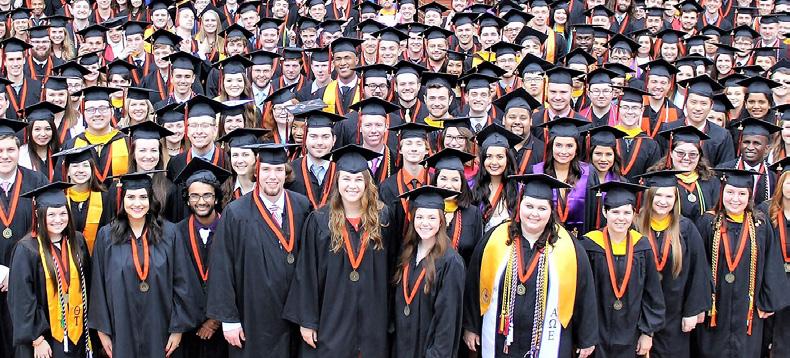
Office of the Dean COLLEGE OF ENGINEERING, ARCHITECTURE AND TECHNOLOGY Oklahoma State University 201 Advanced Technology Research Center Stillwater, Oklahoma 74078-5013 NON-PROFIT ORGANIZATION U.S. POSTAGE PAID MADISON, WI PERMIT NO. 2223
JOIN
Dean Paul Tikalsky invites you to become a member of the Dean’s Club or the College Club. These are distinguished groups whose annual gifts of $5,000+ or $1,500 to the CEAT Fund will support our college’s top priorities and ensure a bright future for CEAT students.
Pokes!
ceat.okstate.edu












































 Paul J. Tikalsky CEAT Dean
Randy Seitsinger Associate Dean, Academic Affairs
Chuck Bunting Associate Dean of Research Ed Kirtley Assistant Dean of Engineering Extension
Raman Singh
Paul J. Tikalsky CEAT Dean
Randy Seitsinger Associate Dean, Academic Affairs
Chuck Bunting Associate Dean of Research Ed Kirtley Assistant Dean of Engineering Extension
Raman Singh


 The members of OSU’s Grand Challenges team are (from left) Christian Griffith, Muwanika Jdiobe, Angela Peter and Jackson Moore.
The members of OSU’s Grand Challenges team are (from left) Christian Griffith, Muwanika Jdiobe, Angela Peter and Jackson Moore.



 Members of the hypogravity simulator project prepare a demonstration at the CEAT Senior Design Expo.
Students from the Wind Turbine/ Sculpture/Light Show interdisciplinary design team prepare to install their 40-foot tall wind-energy project in downtown Stillwater.
Members of the hypogravity simulator project prepare a demonstration at the CEAT Senior Design Expo.
Students from the Wind Turbine/ Sculpture/Light Show interdisciplinary design team prepare to install their 40-foot tall wind-energy project in downtown Stillwater.




































 OSU graduate students Alvin Ngo, Mitch Ford and Chris Barton monitor dolphin behavior as drone playback is presented to them.
OSU graduate students Alvin Ngo, Mitch Ford and Chris Barton monitor dolphin behavior as drone playback is presented to them.





 USRI’s mobile ground station and launch system were developed to assist in the deployment of unmanned aircraft for severe storm research, including capabilities to launch and control UAVs while en route to potential hazardous storms. This includes such aircraft as the jet powered Tornado Intercept Aircraft (TIA) and the Meteorological Analysis and Research Investigation Aircraft (MARIA), shown in the foreground.
The new home of the Unmanned Systems Research Institute
USRI’s mobile ground station and launch system were developed to assist in the deployment of unmanned aircraft for severe storm research, including capabilities to launch and control UAVs while en route to potential hazardous storms. This includes such aircraft as the jet powered Tornado Intercept Aircraft (TIA) and the Meteorological Analysis and Research Investigation Aircraft (MARIA), shown in the foreground.
The new home of the Unmanned Systems Research Institute




 Jill Blake Development Associate
Jill Blake Development Associate


































